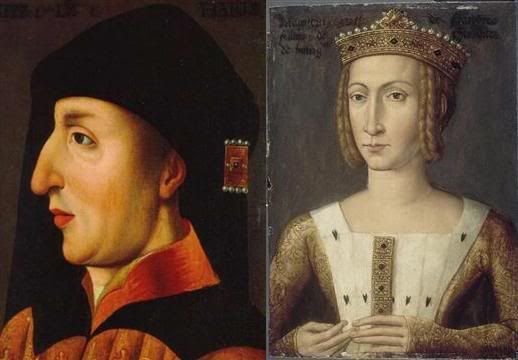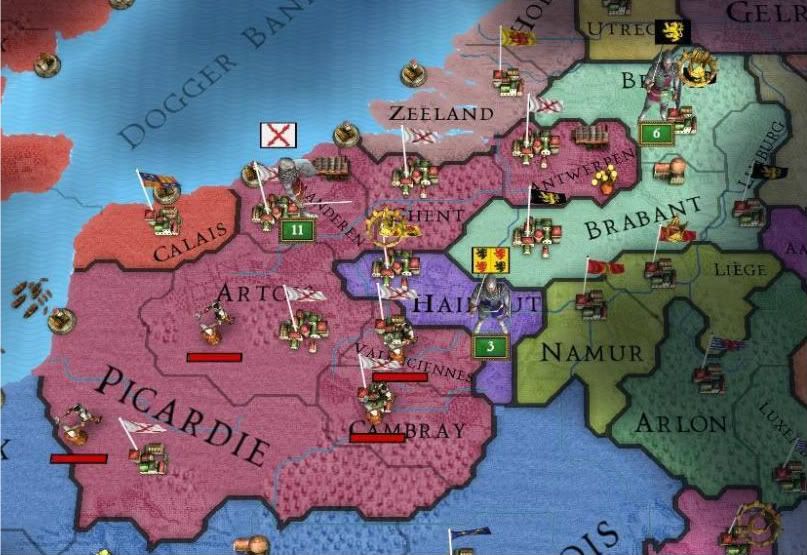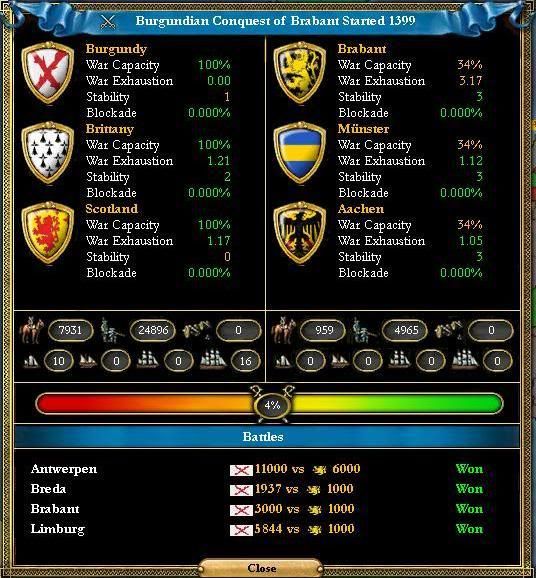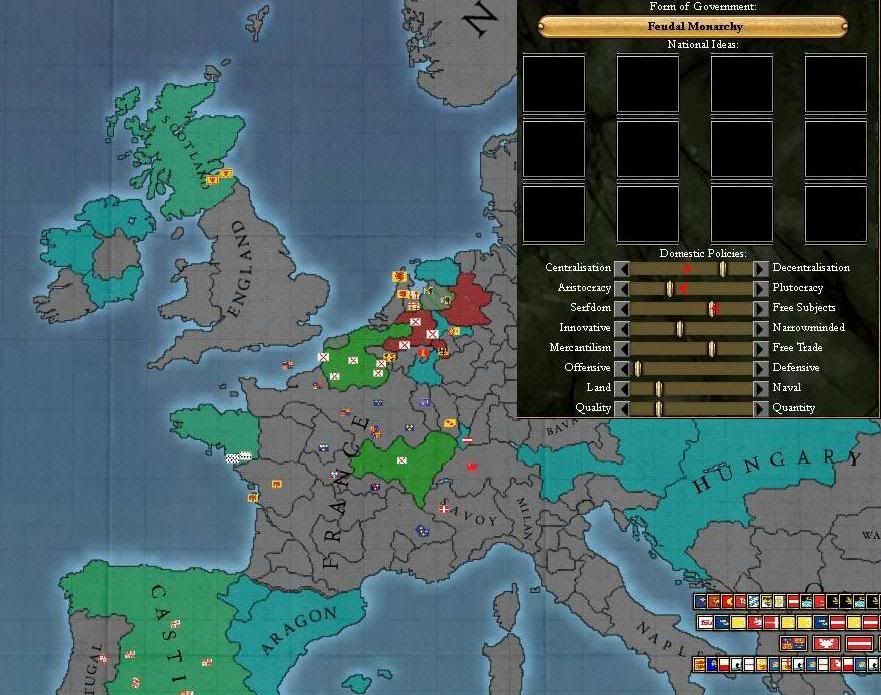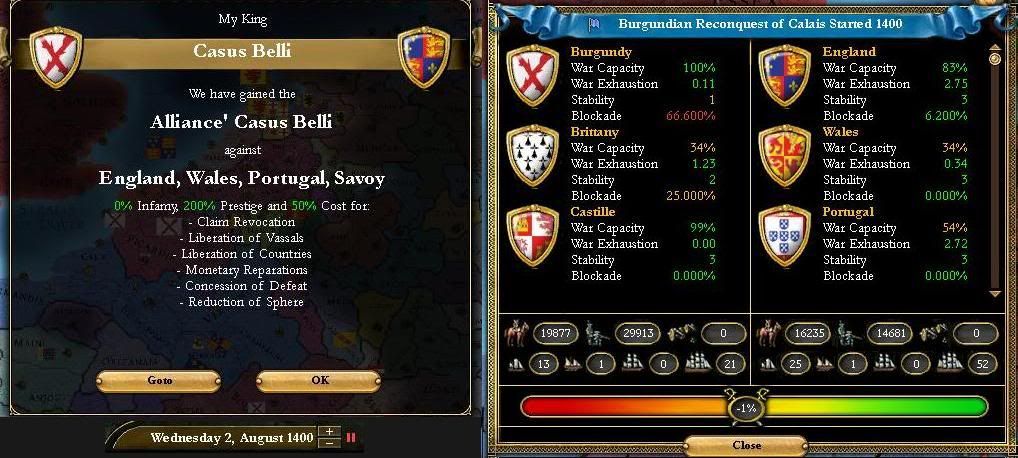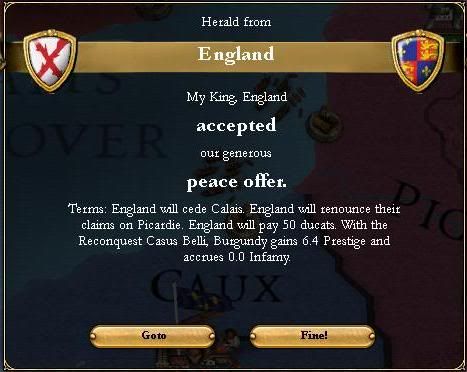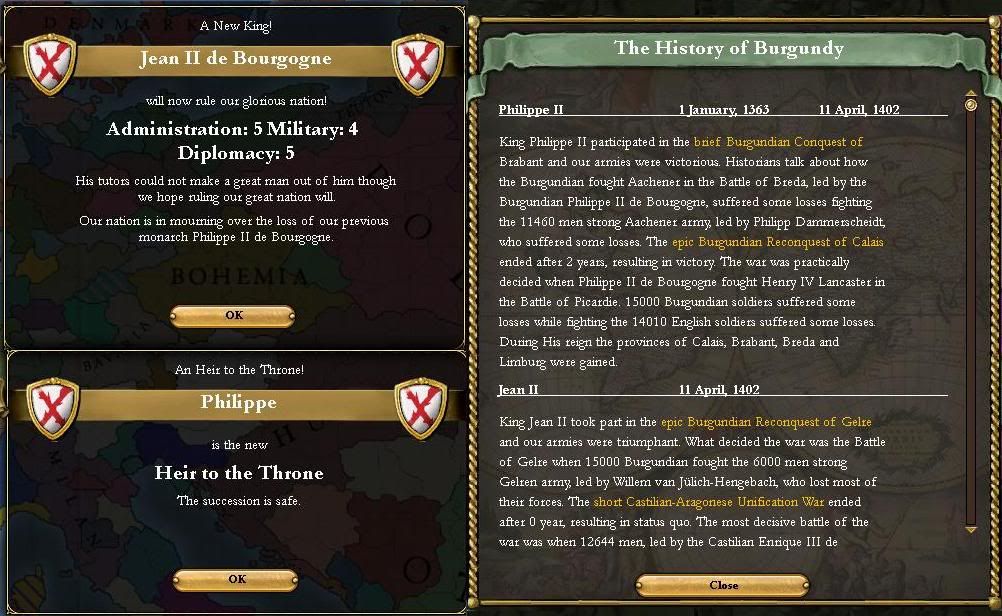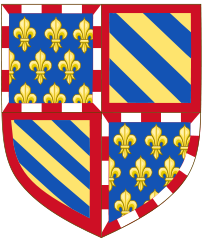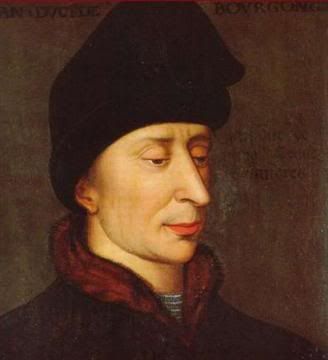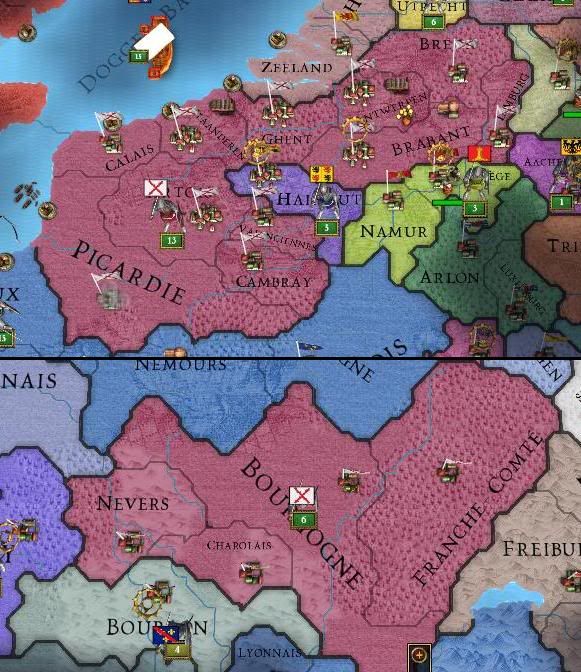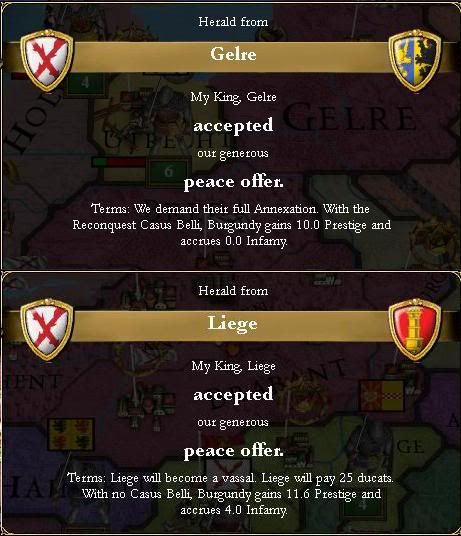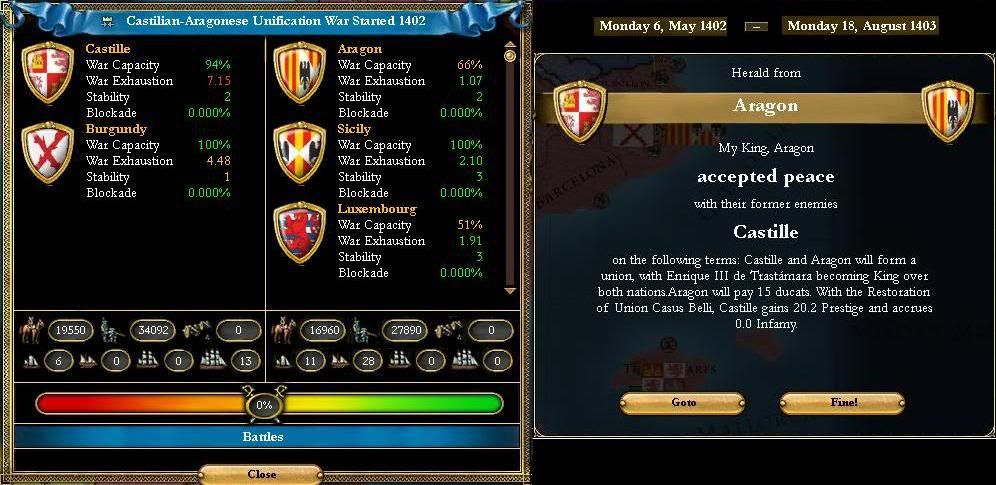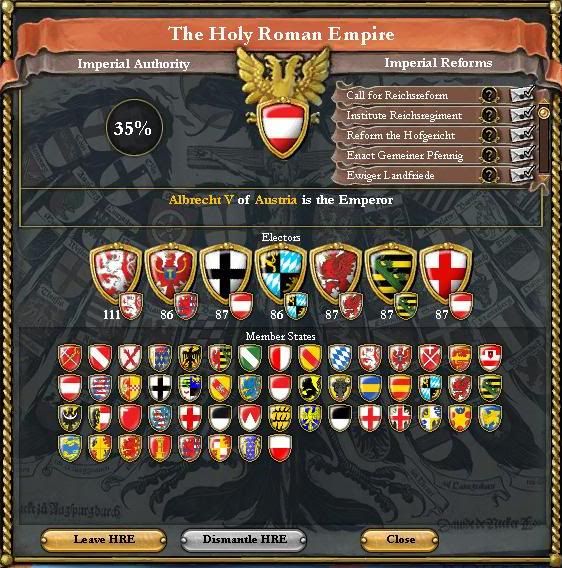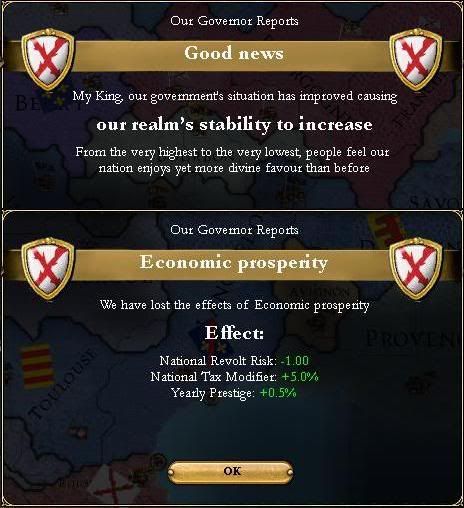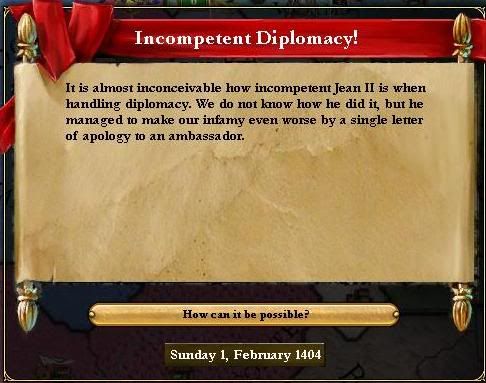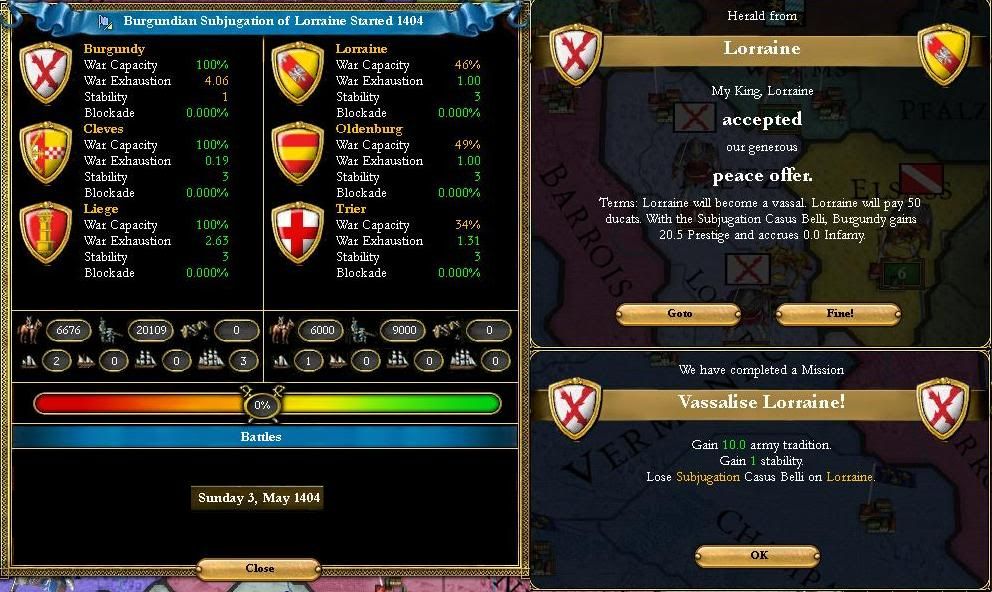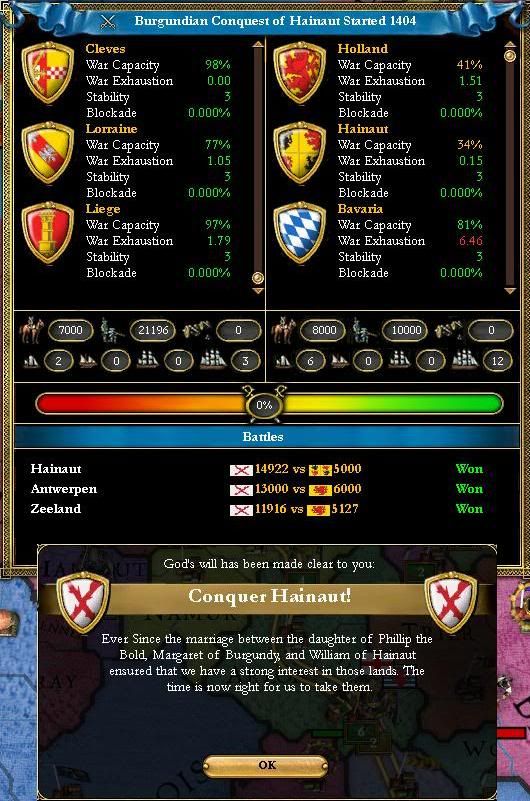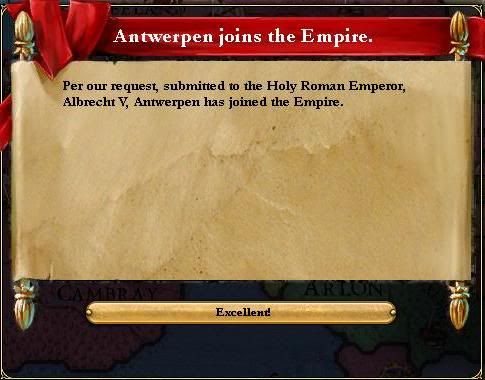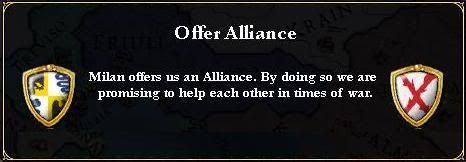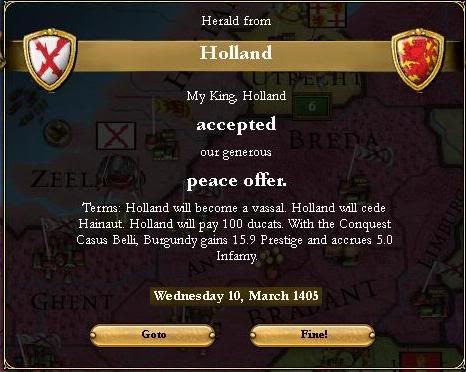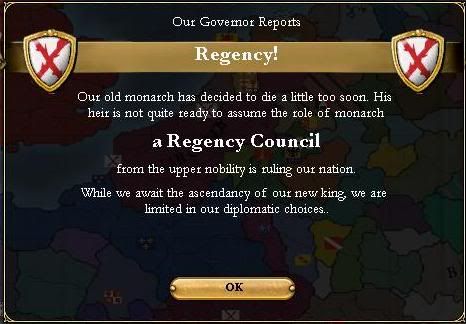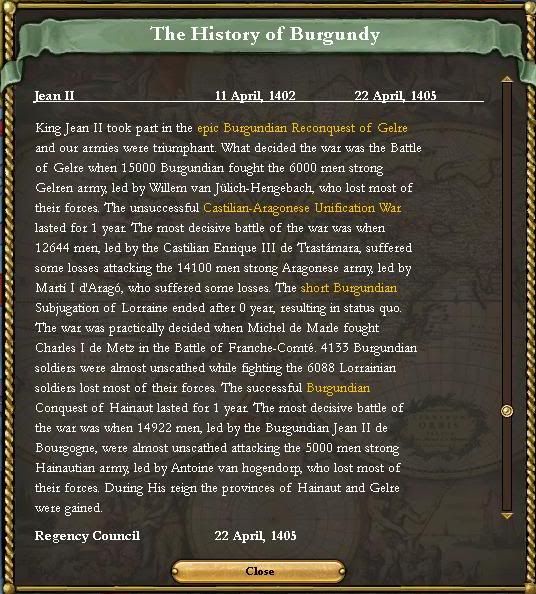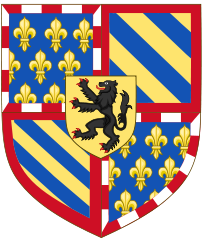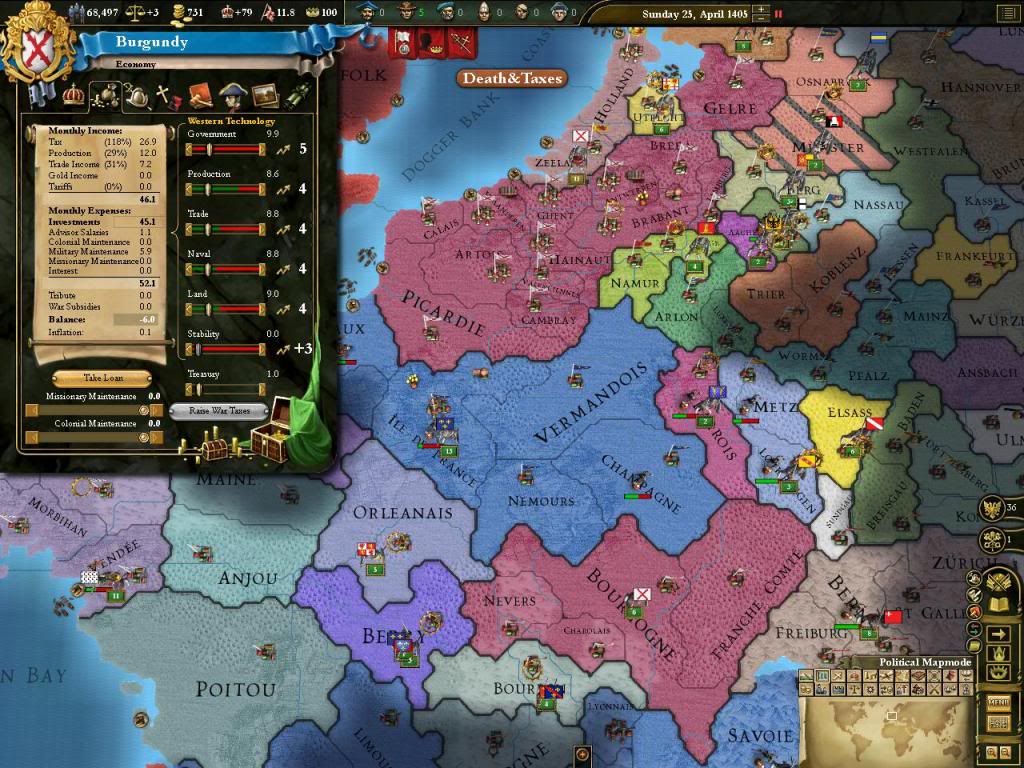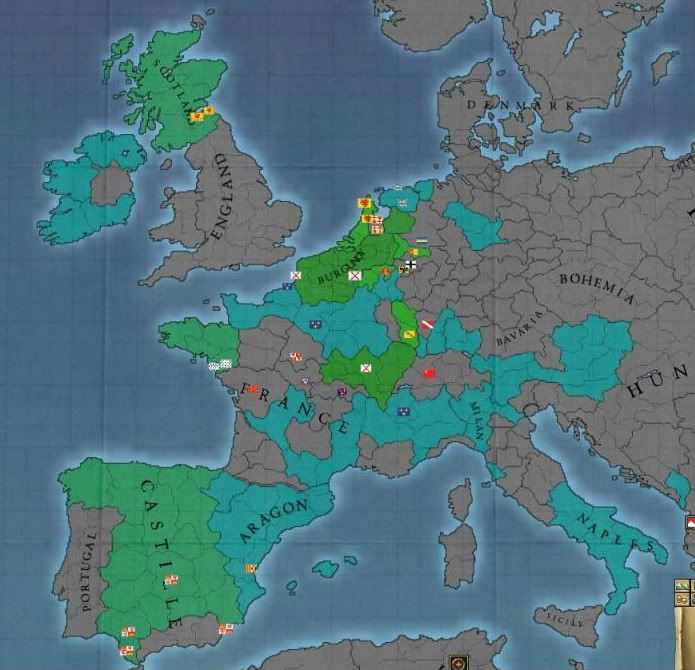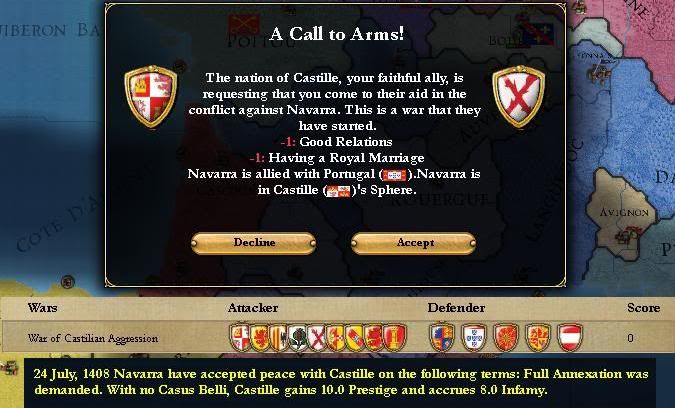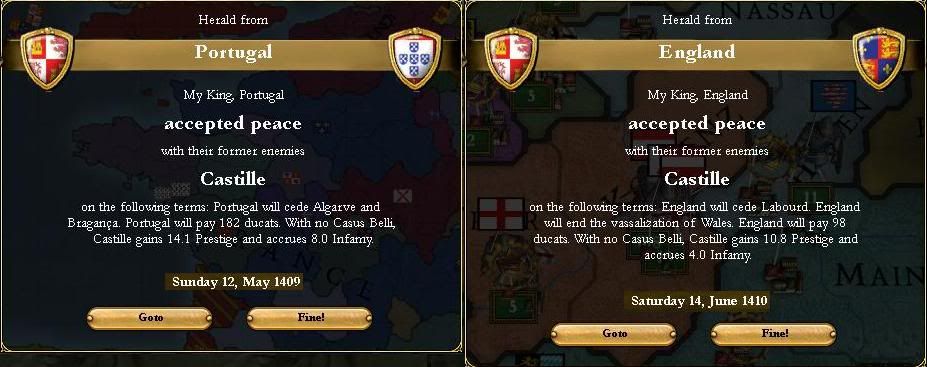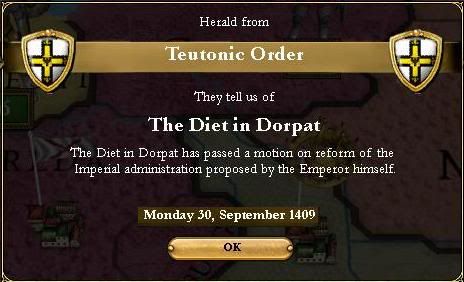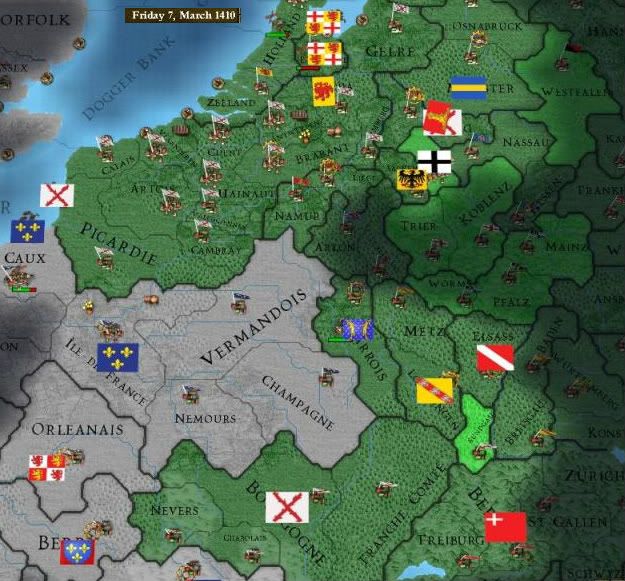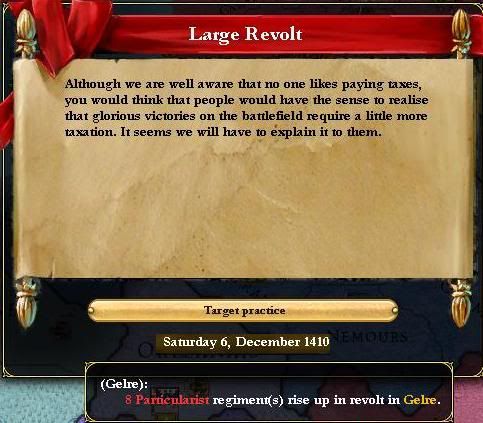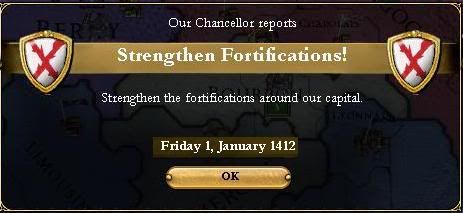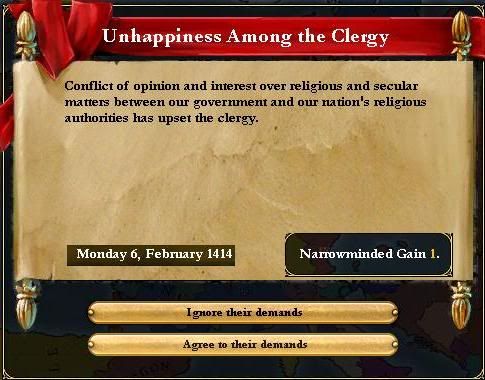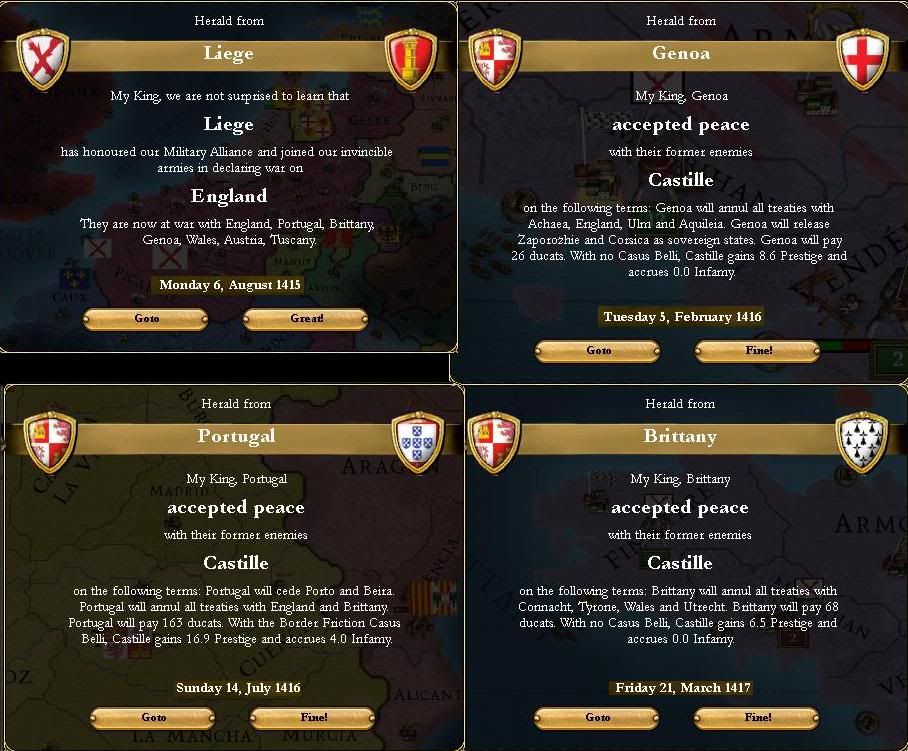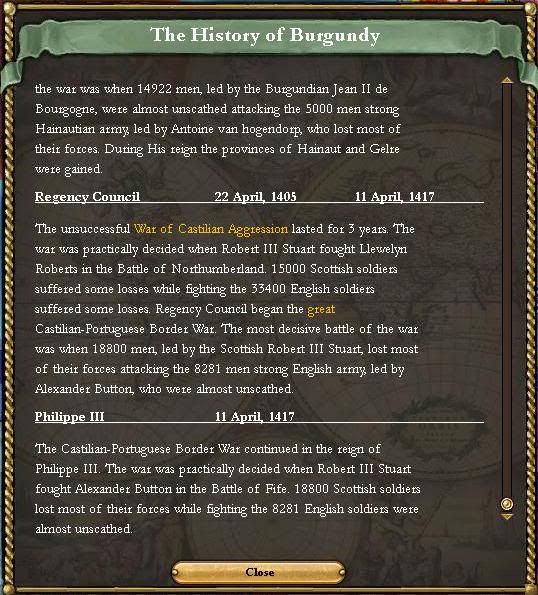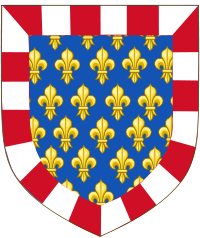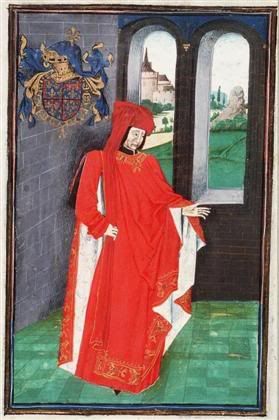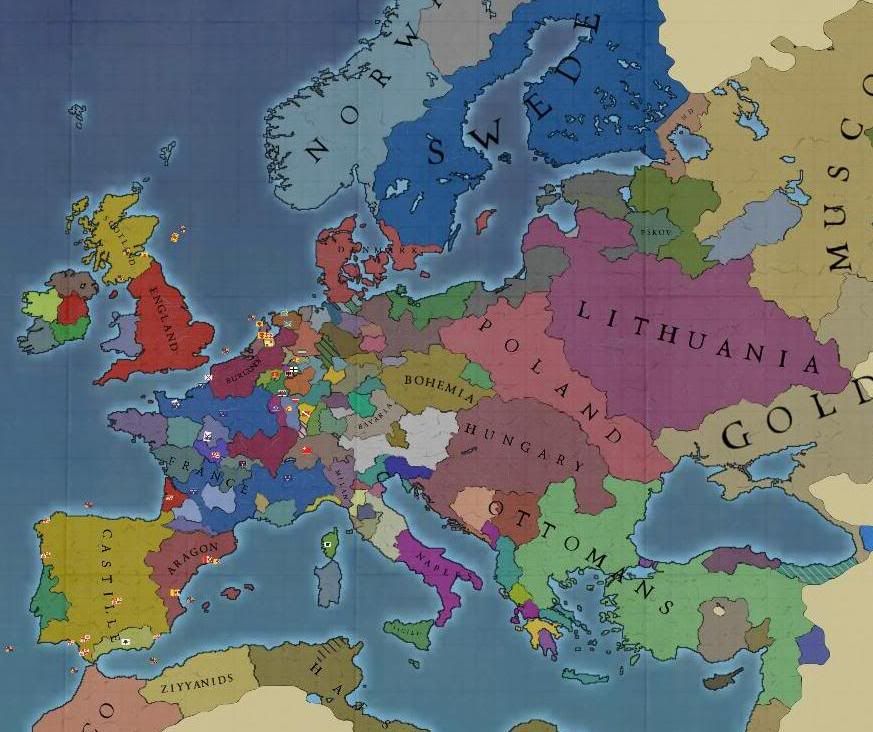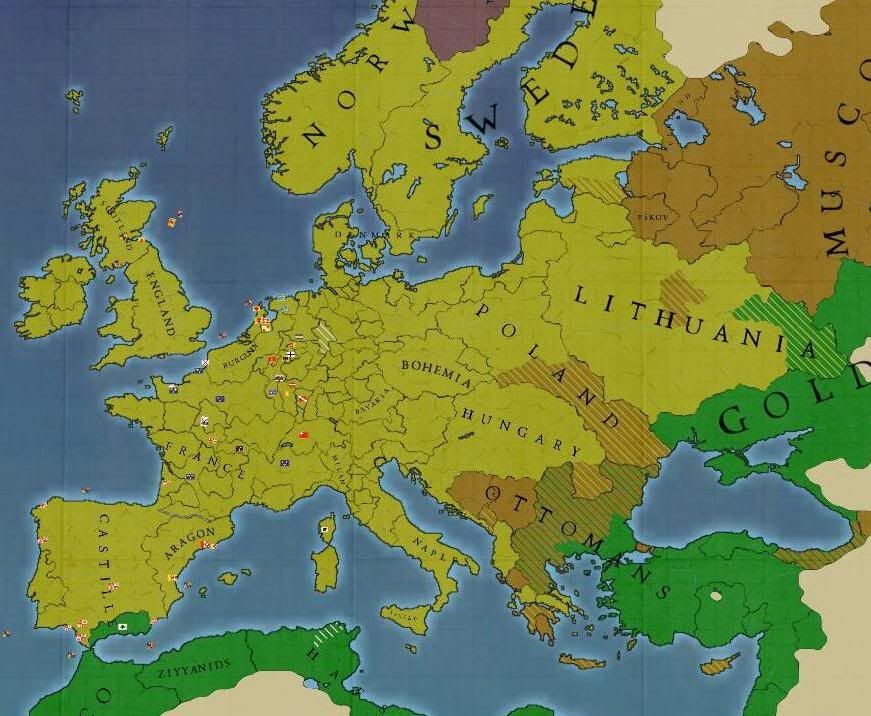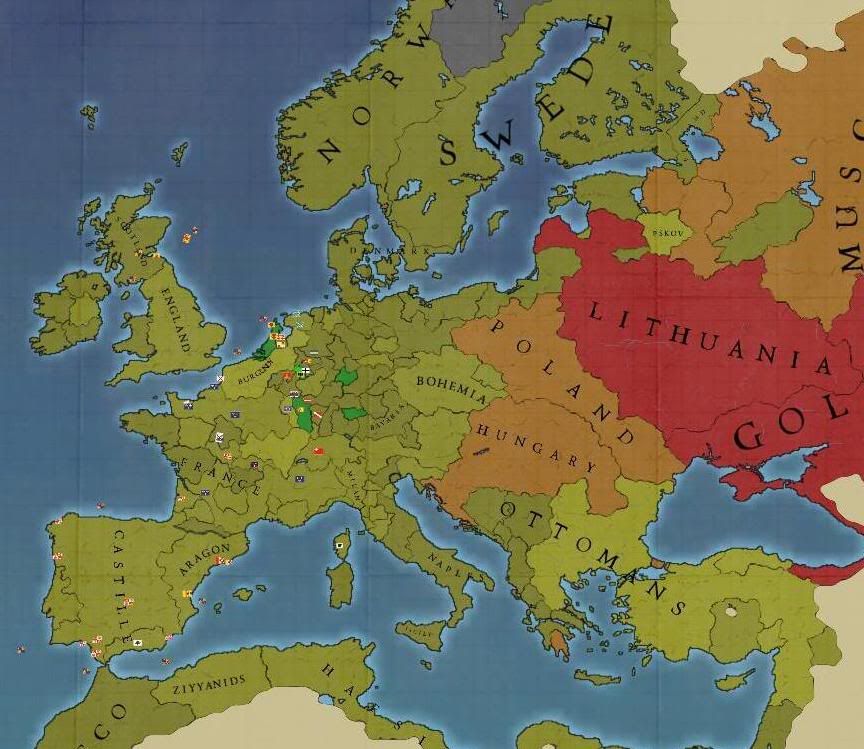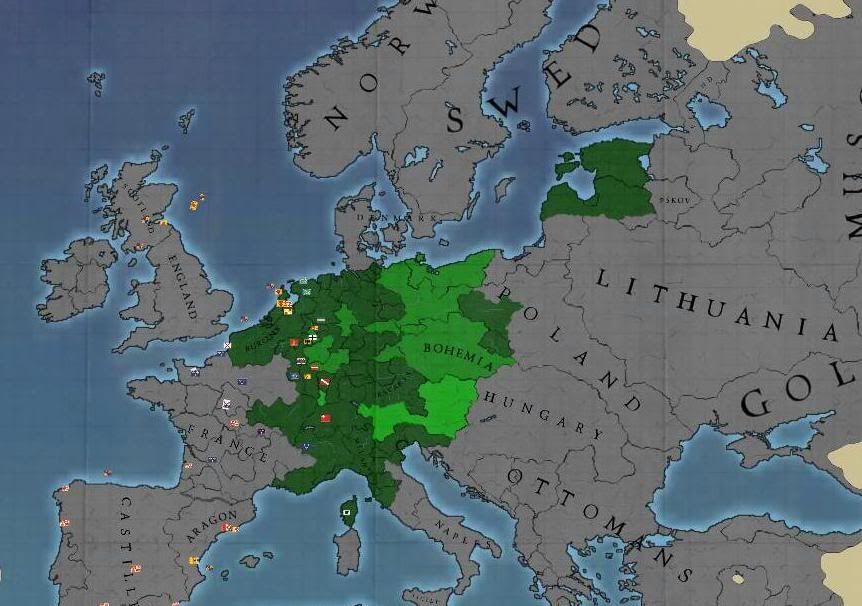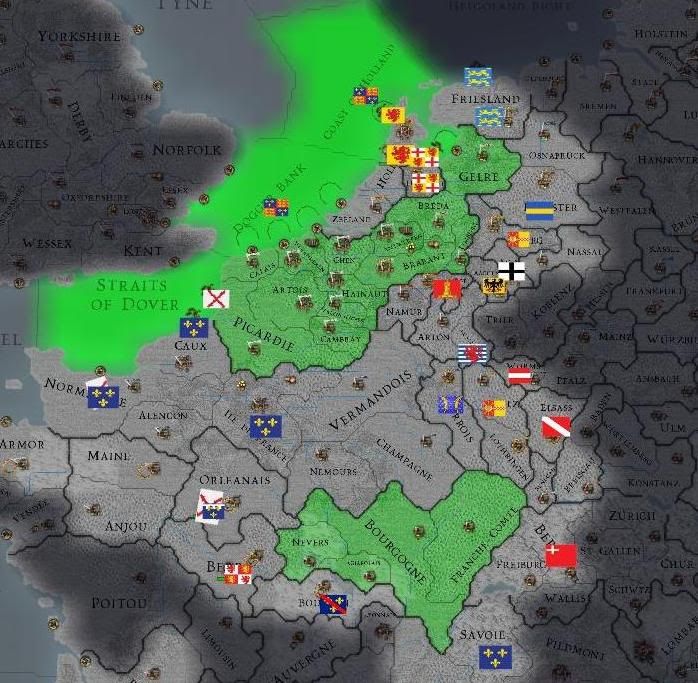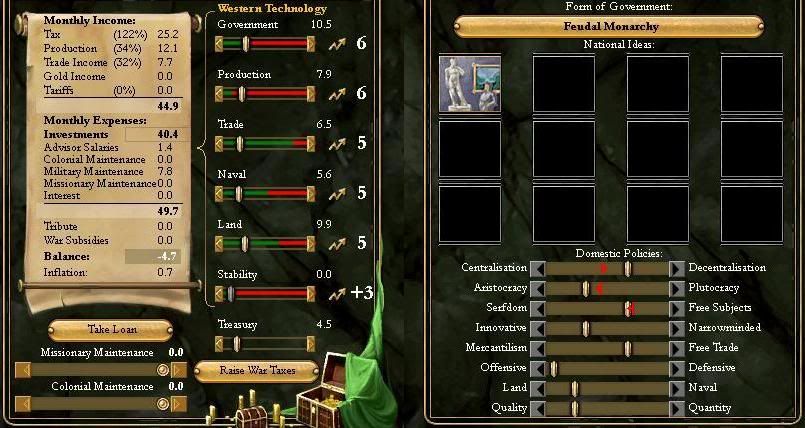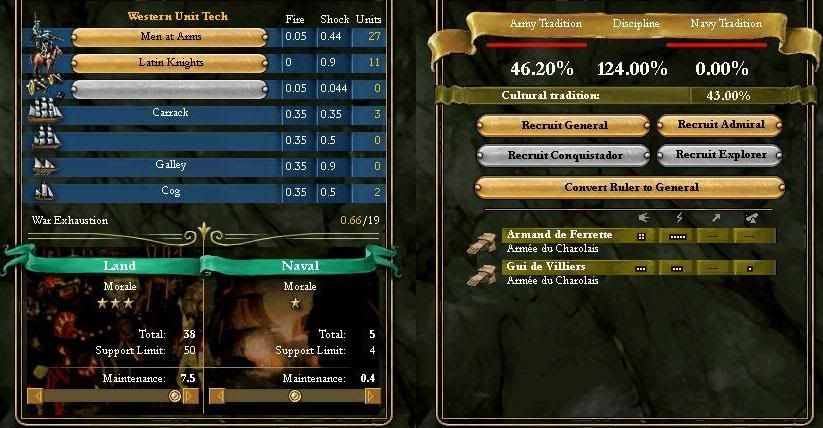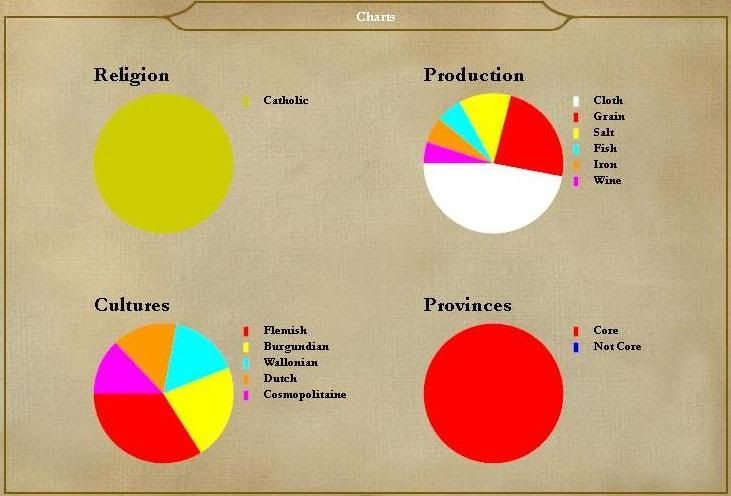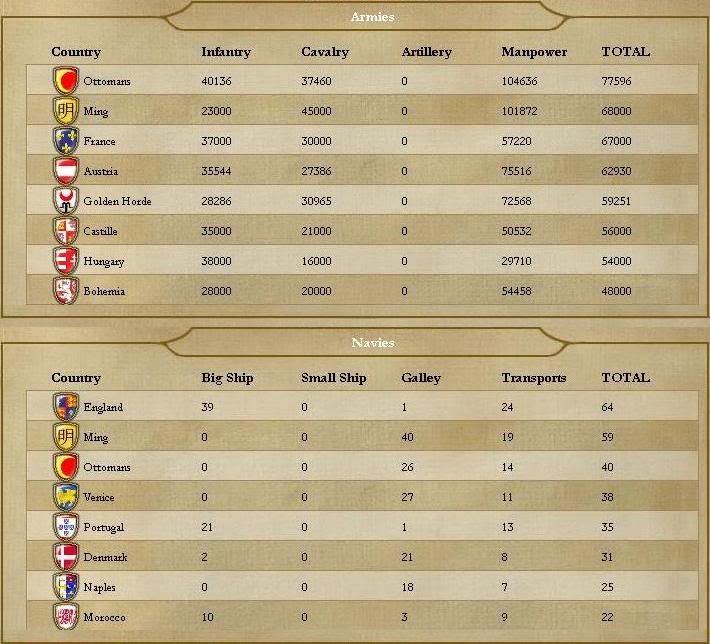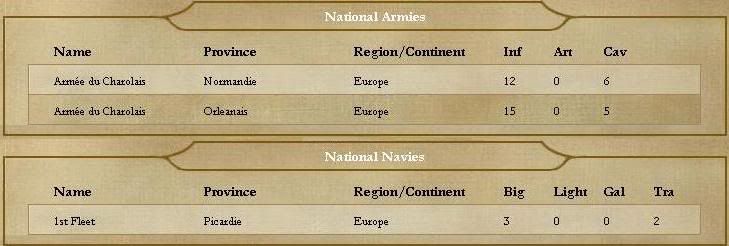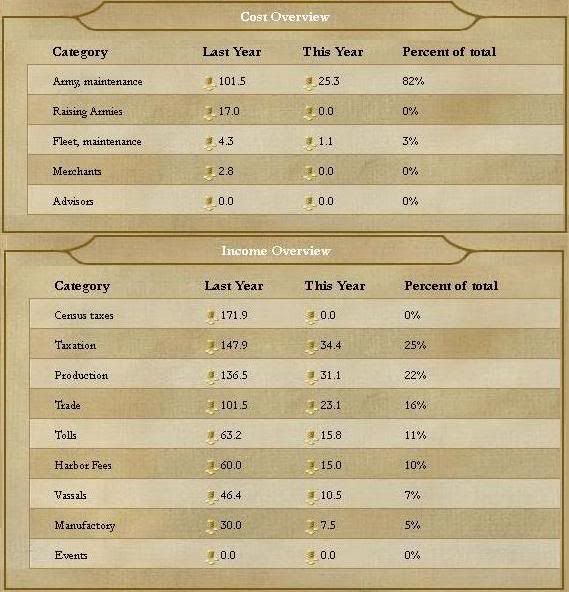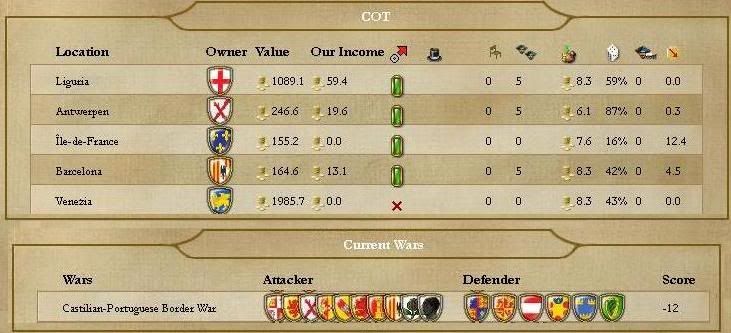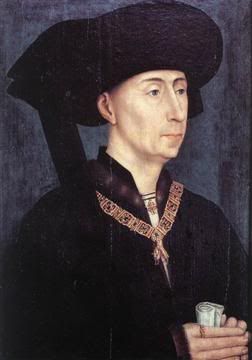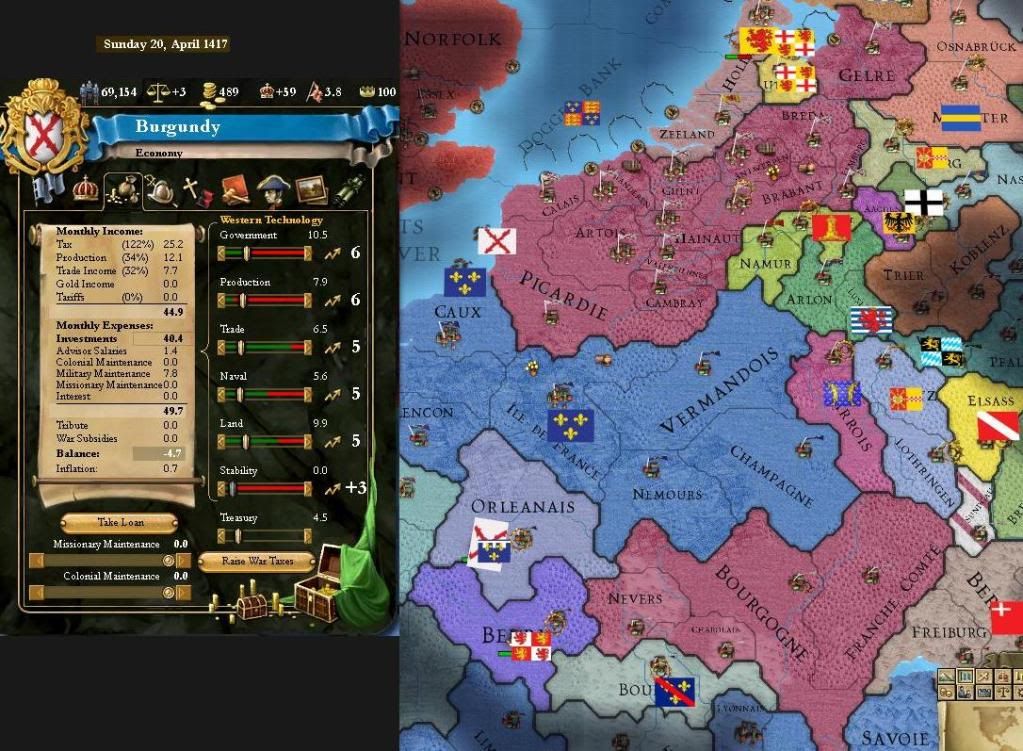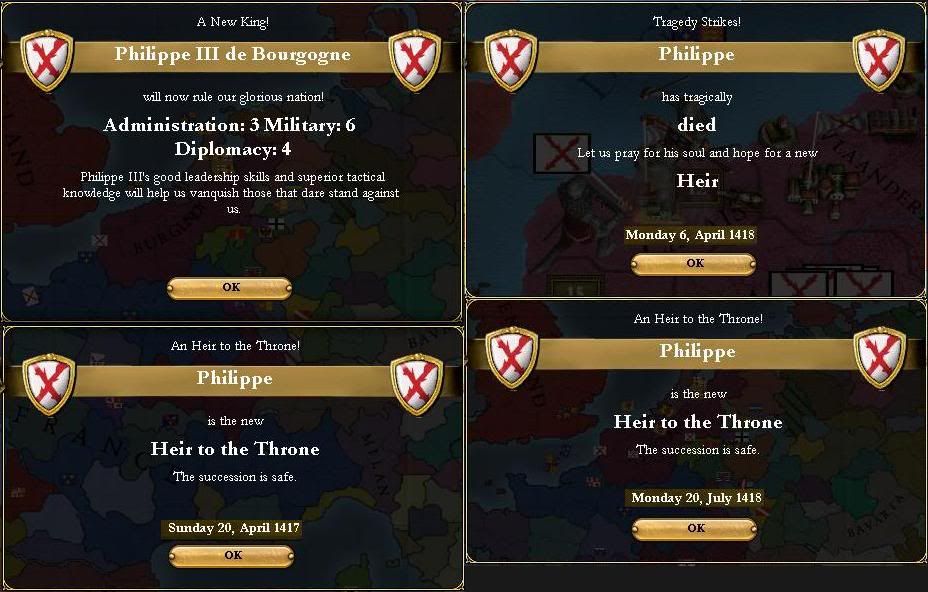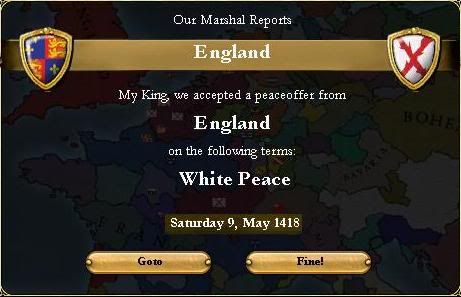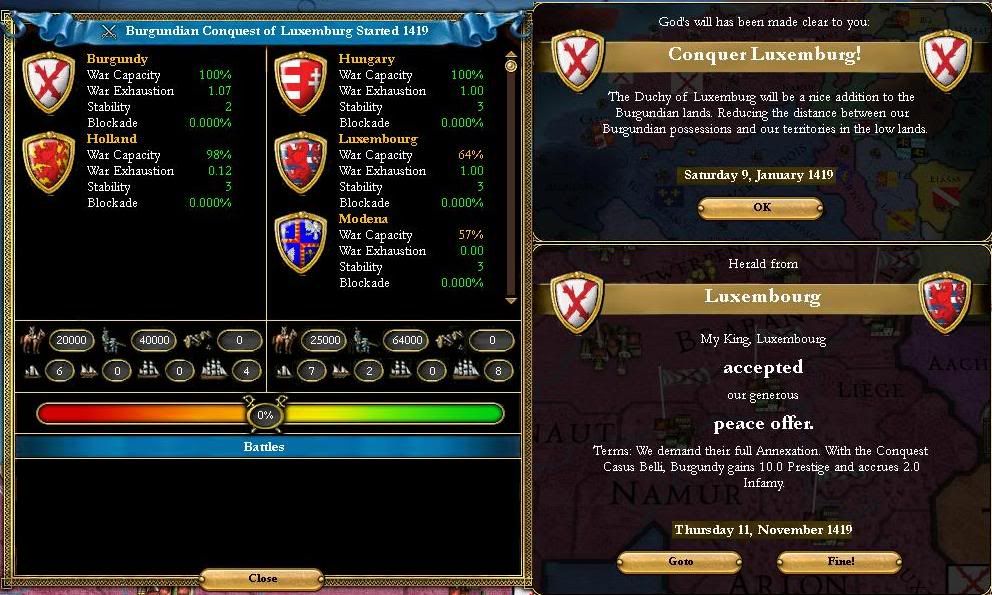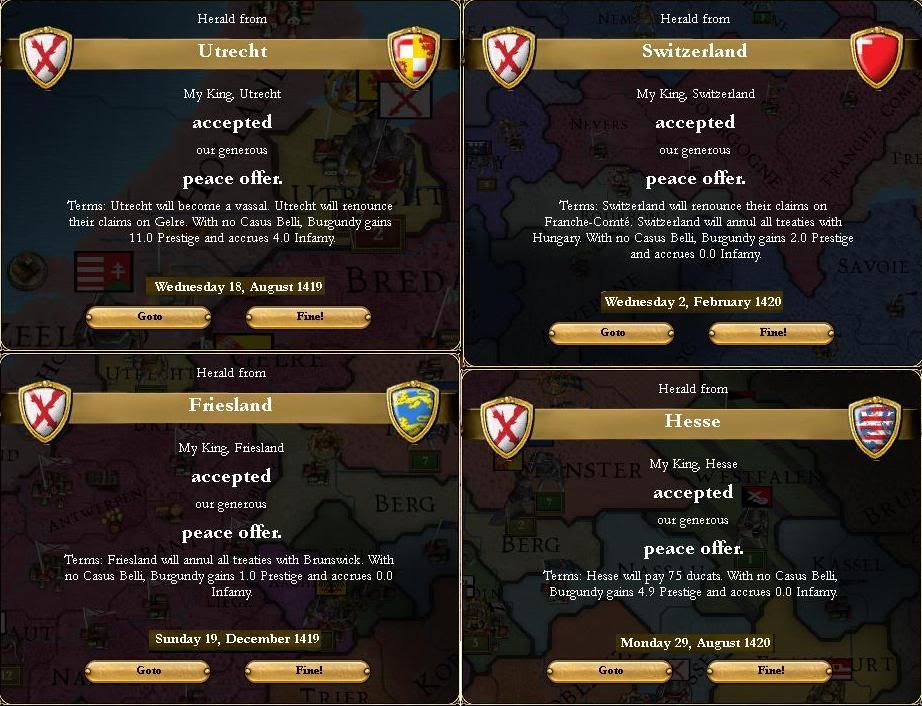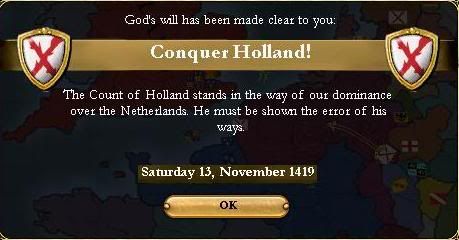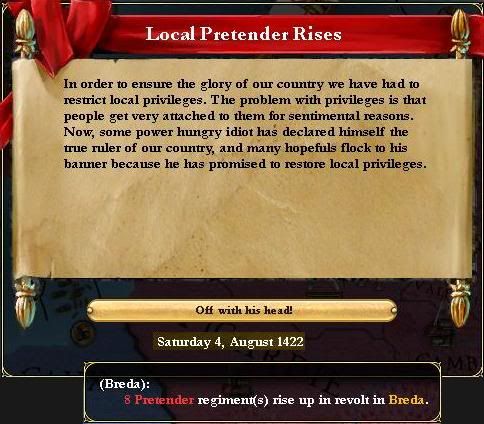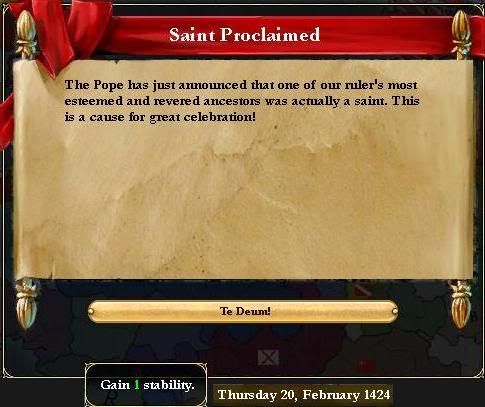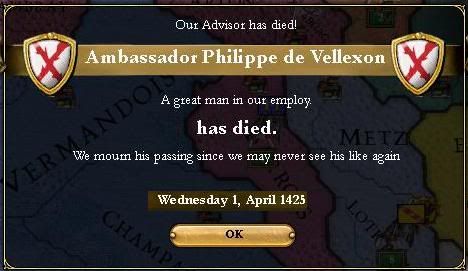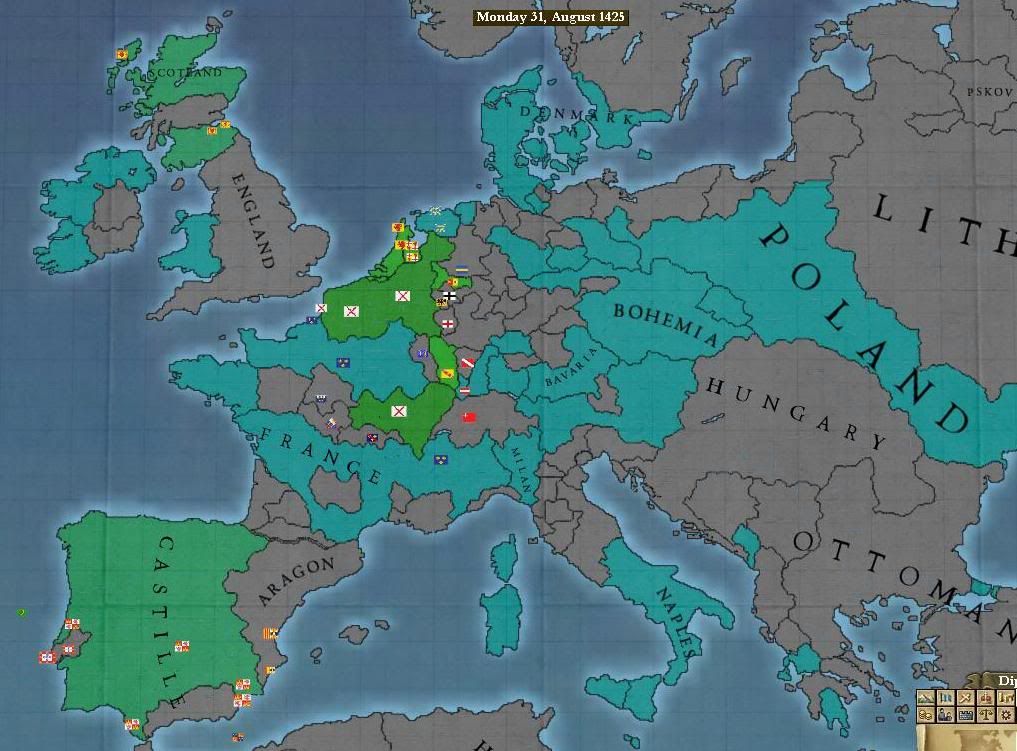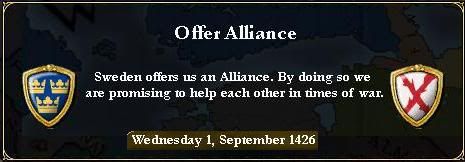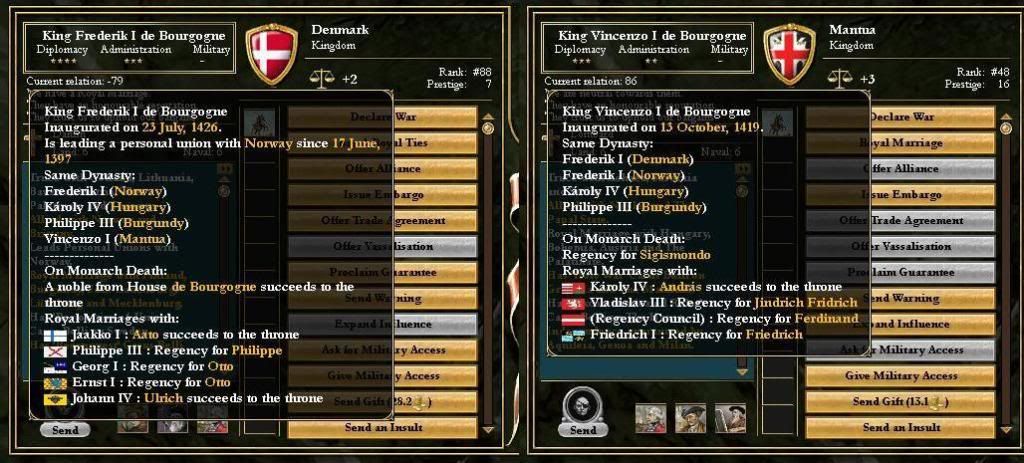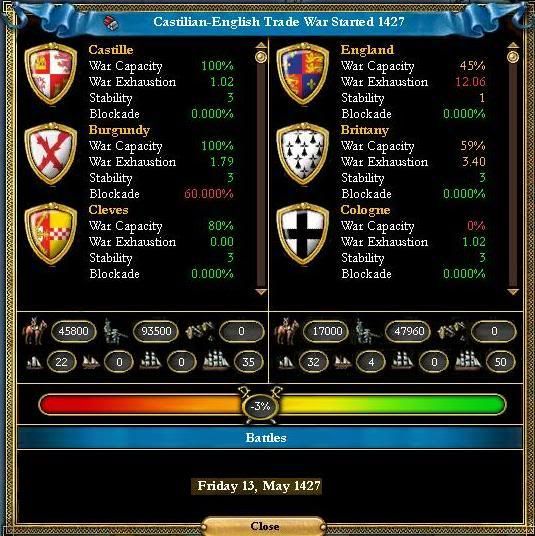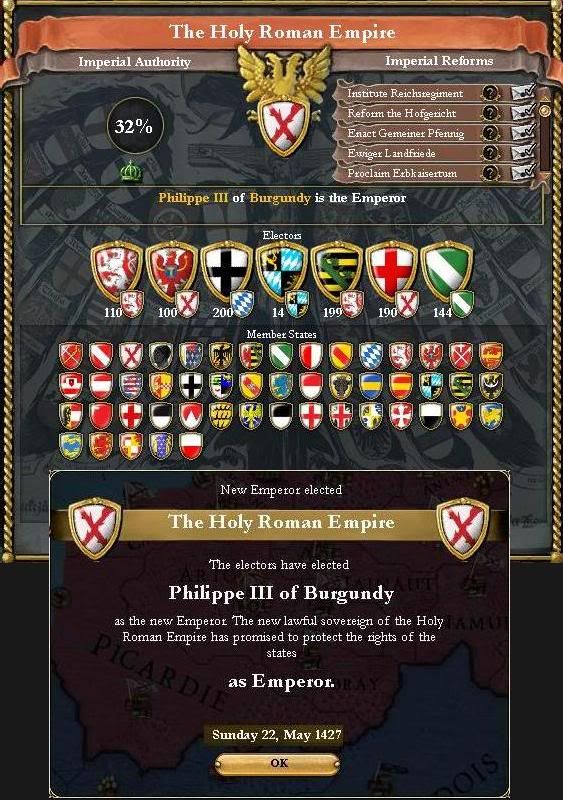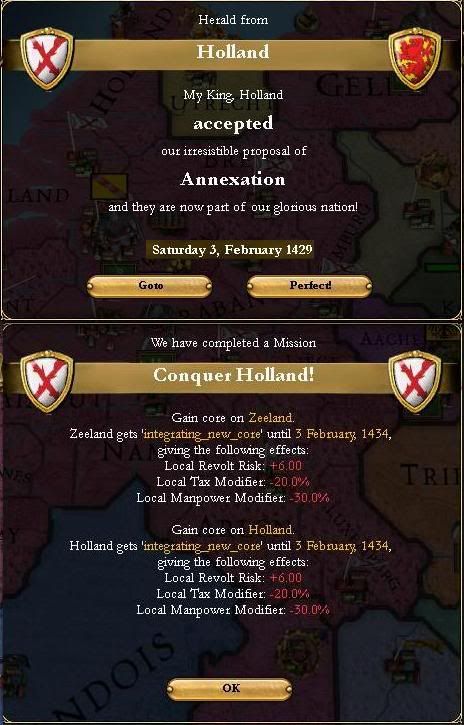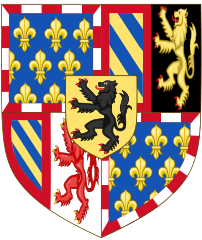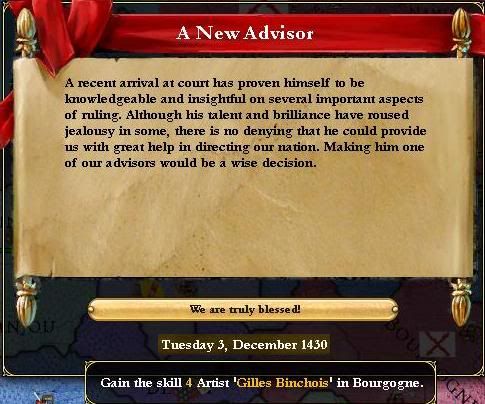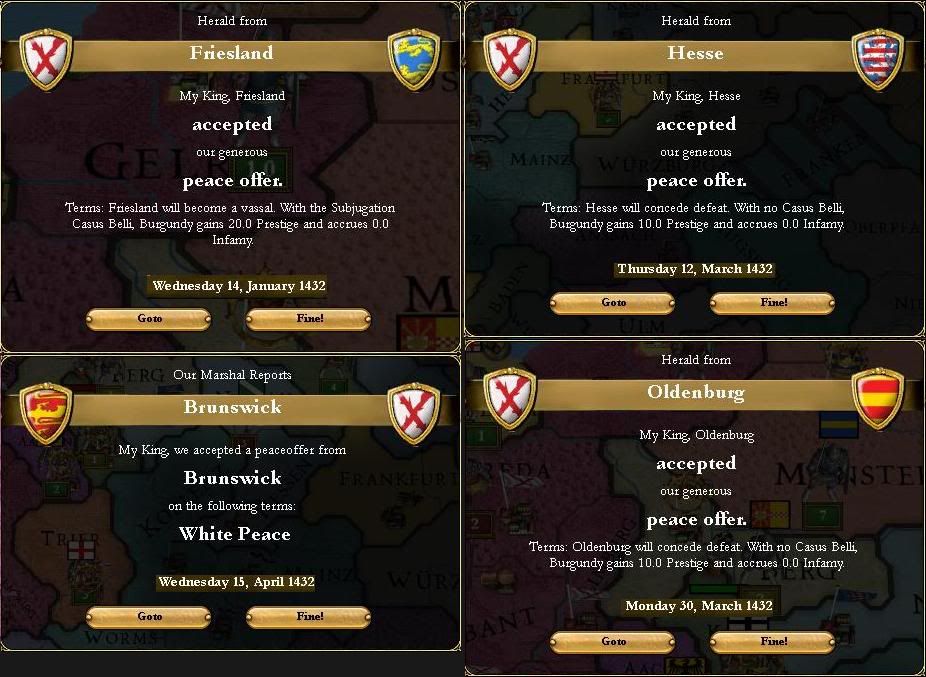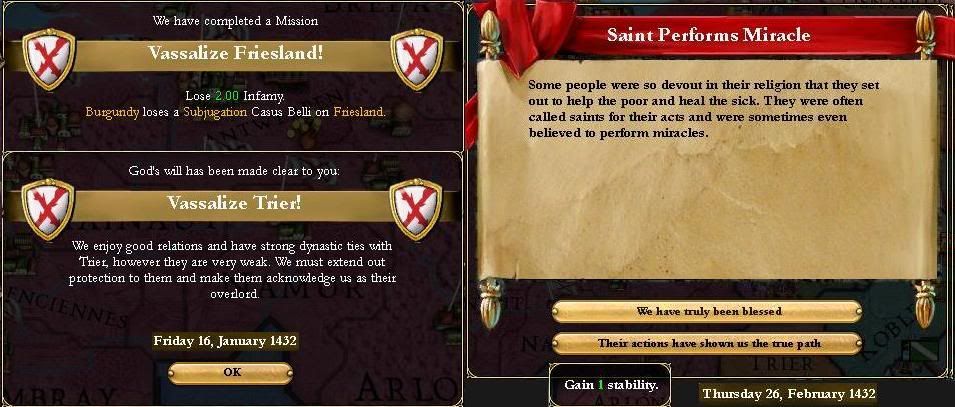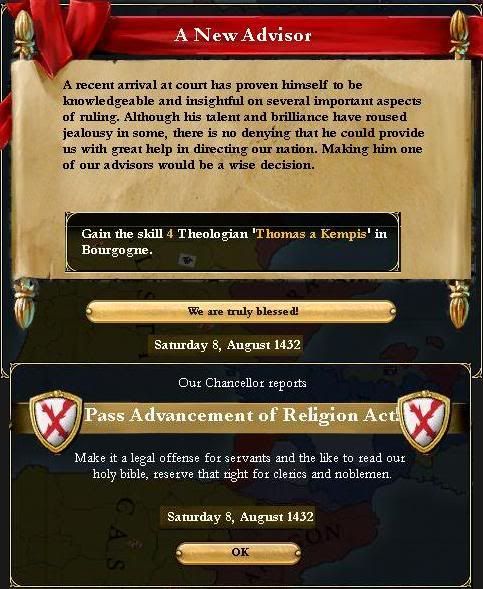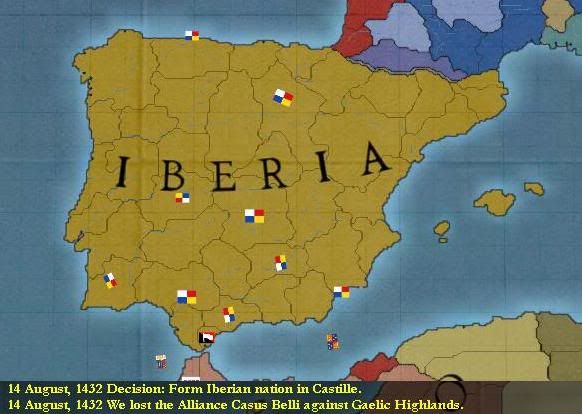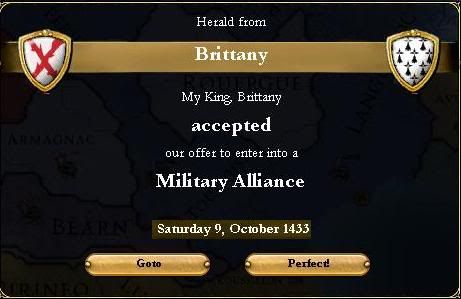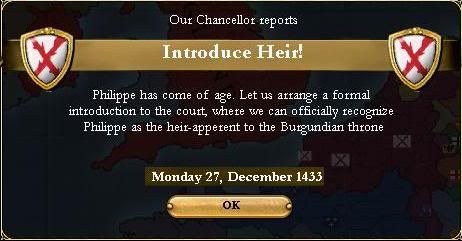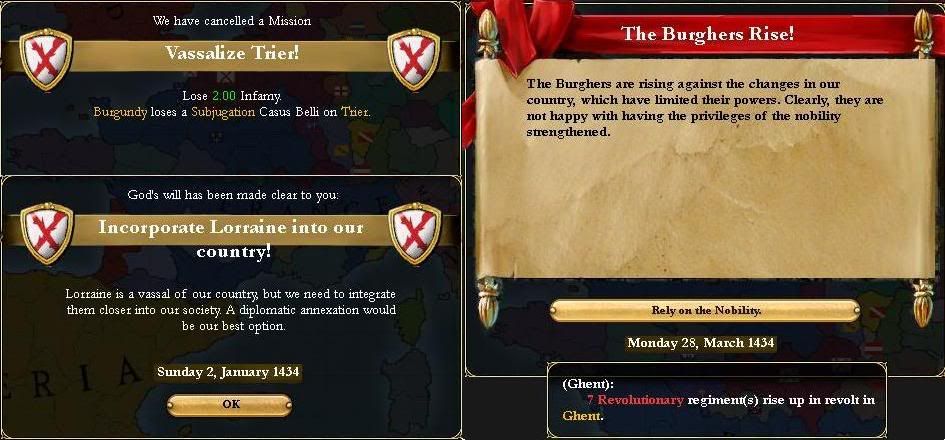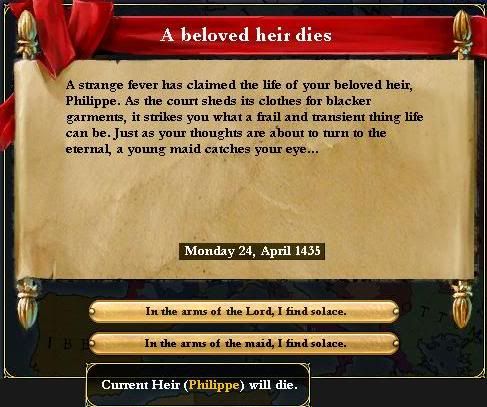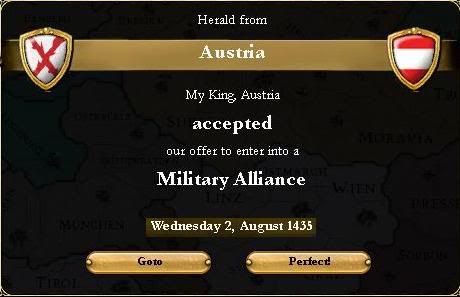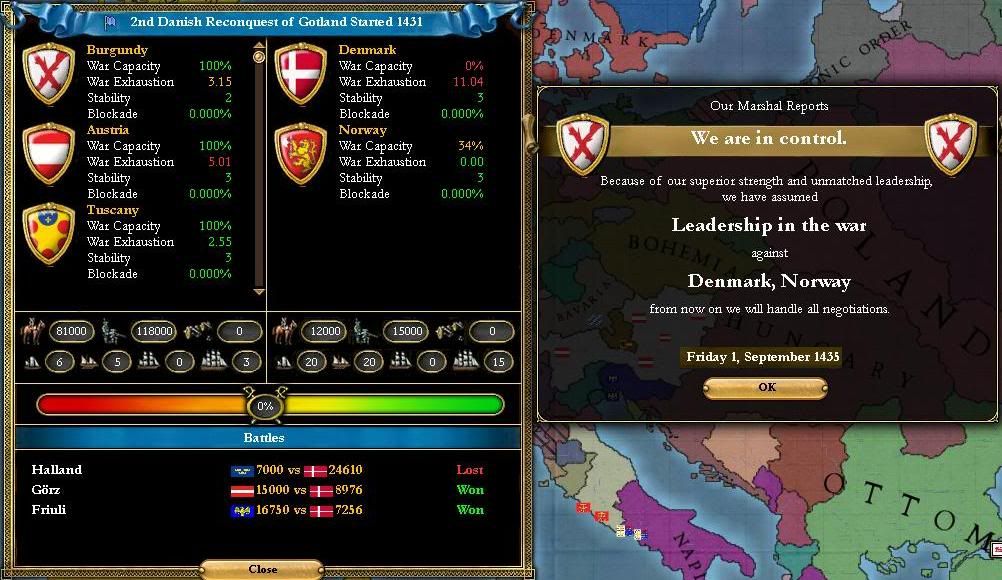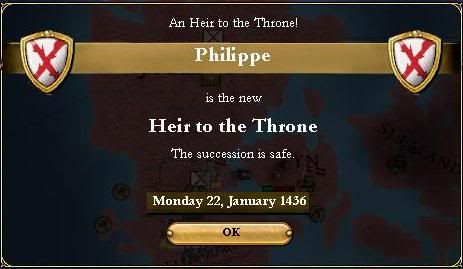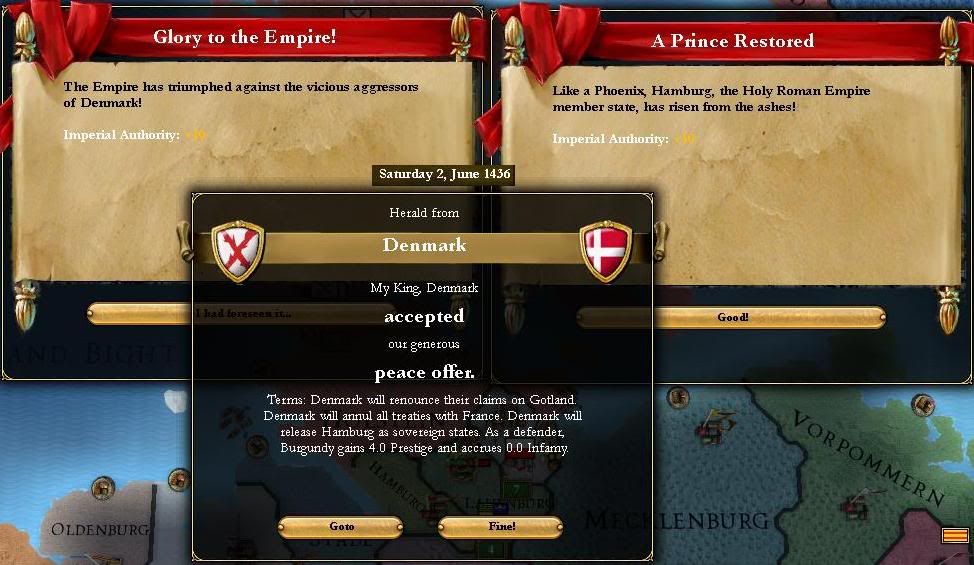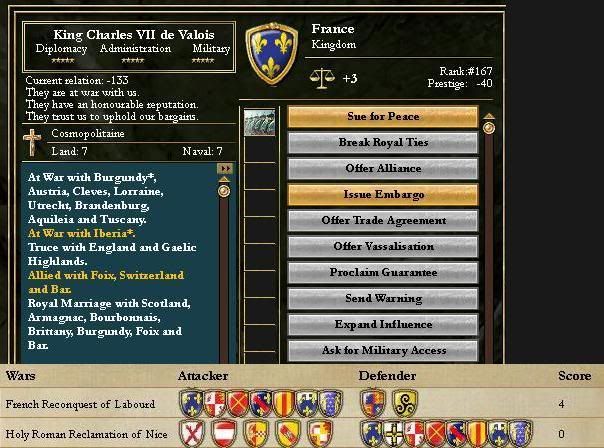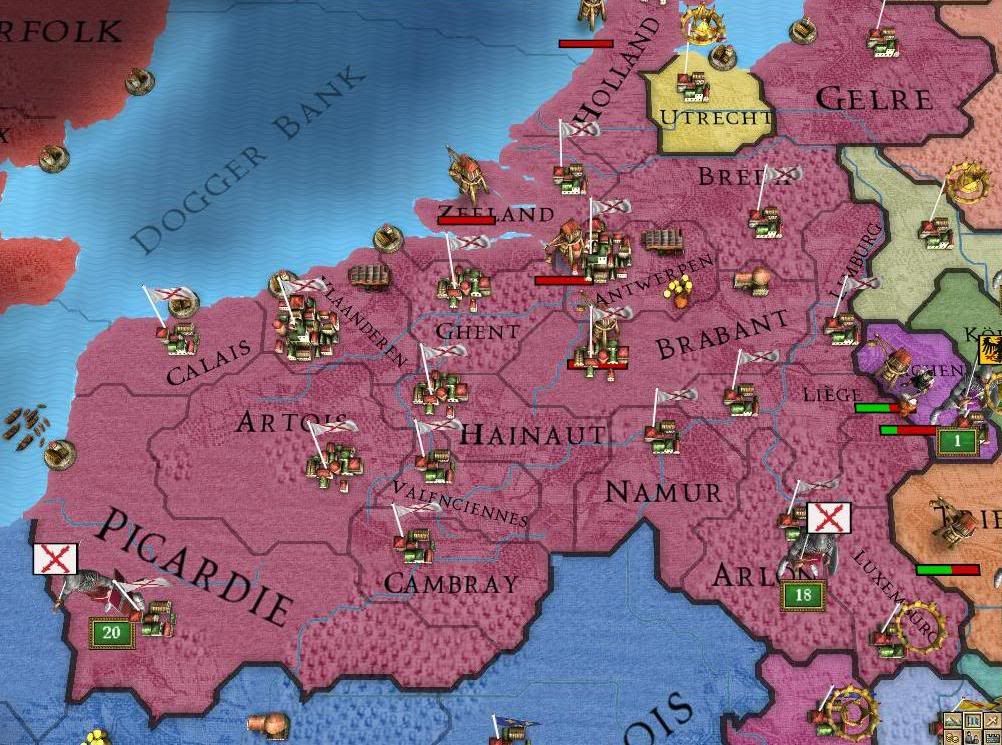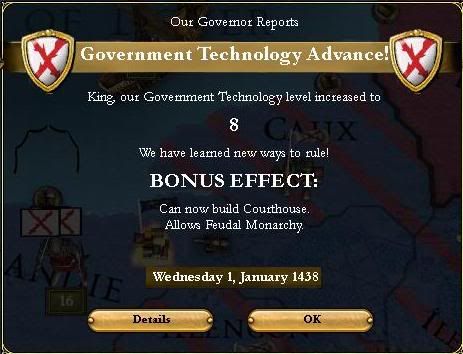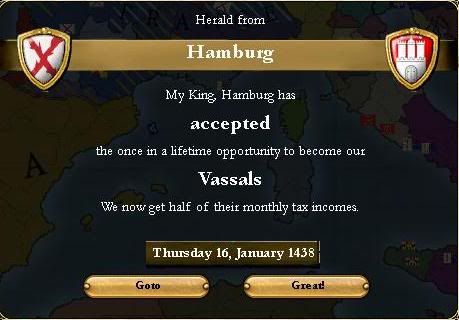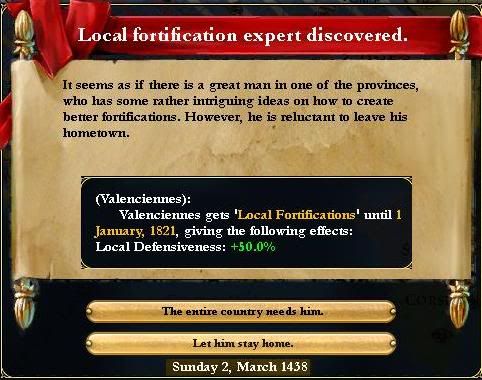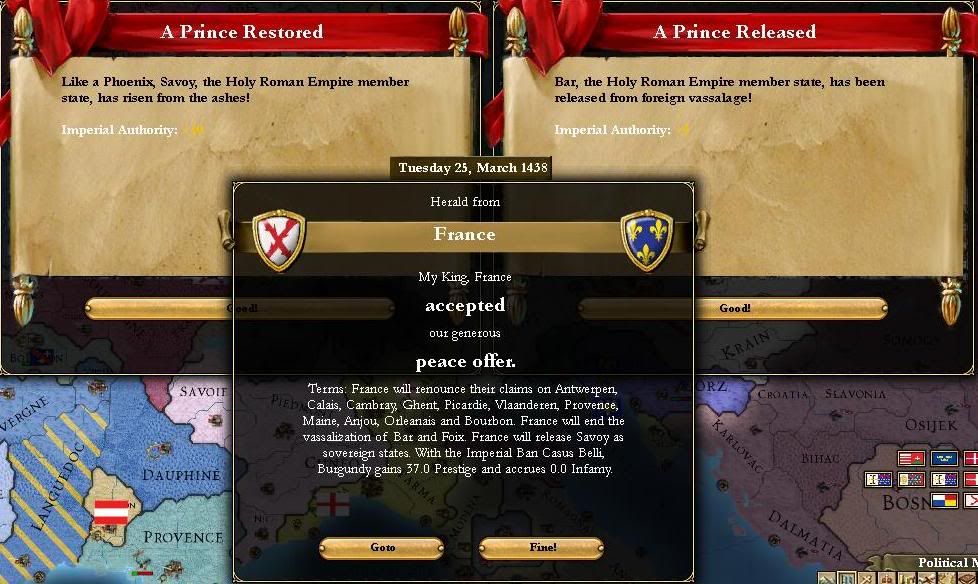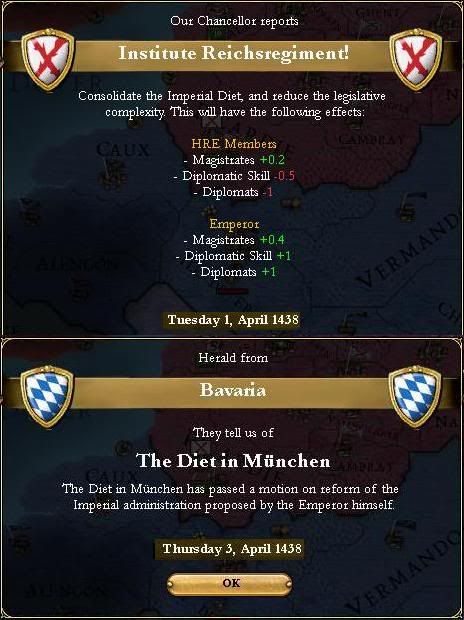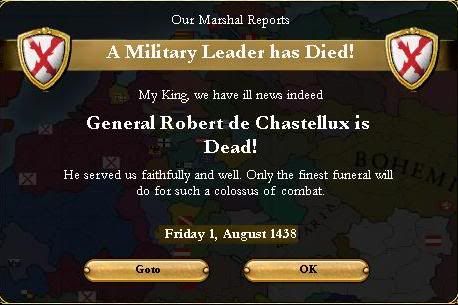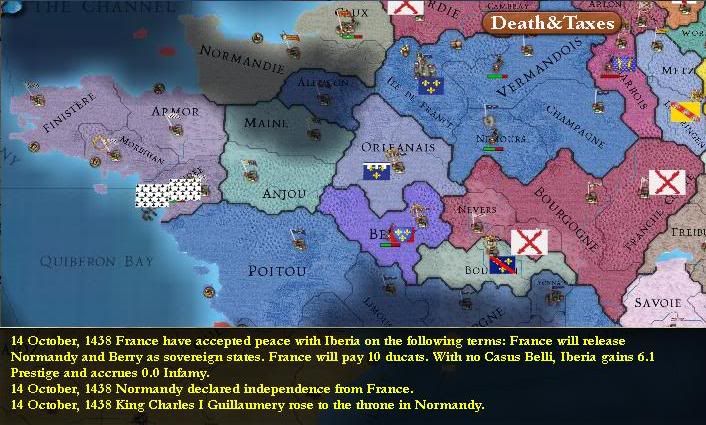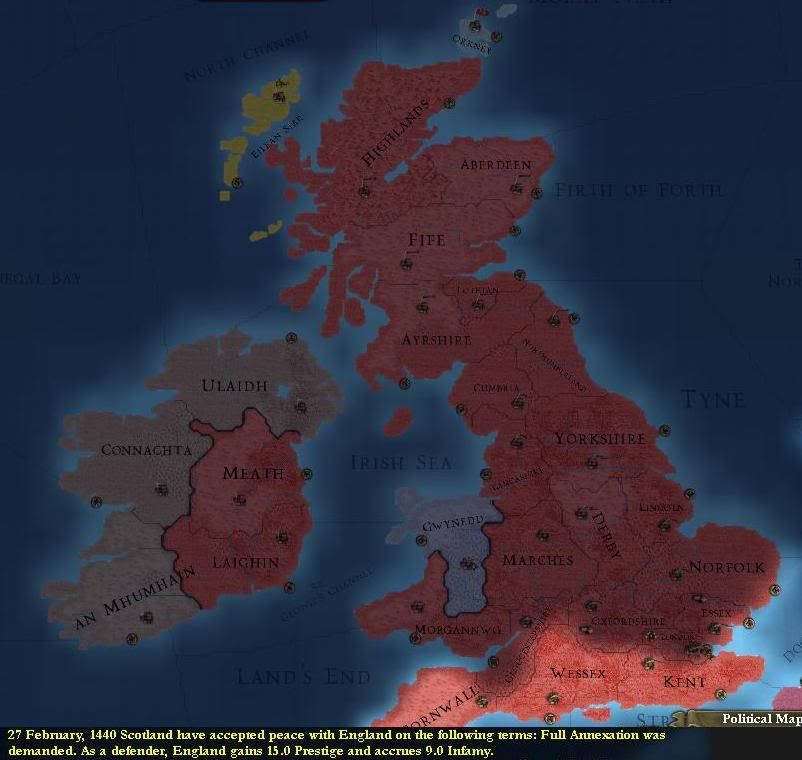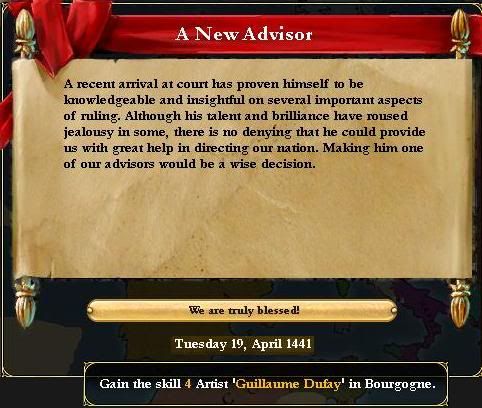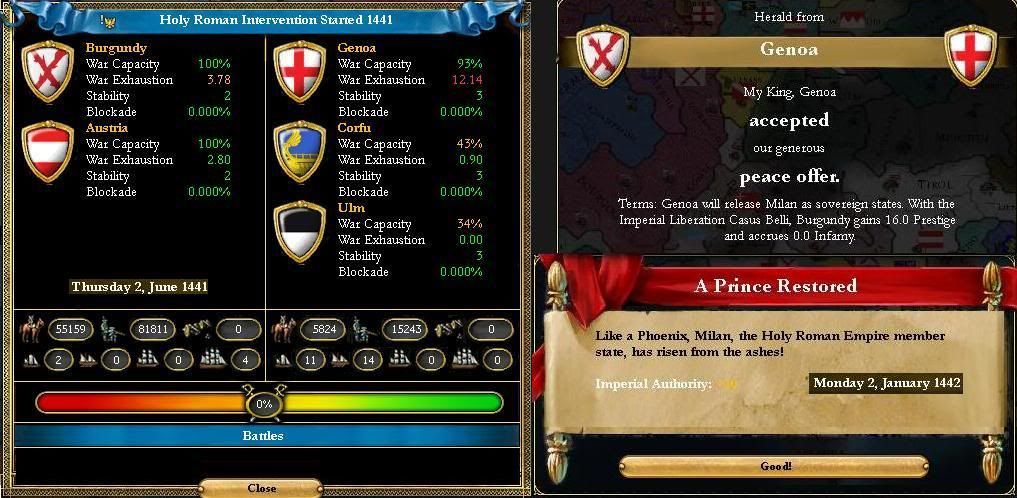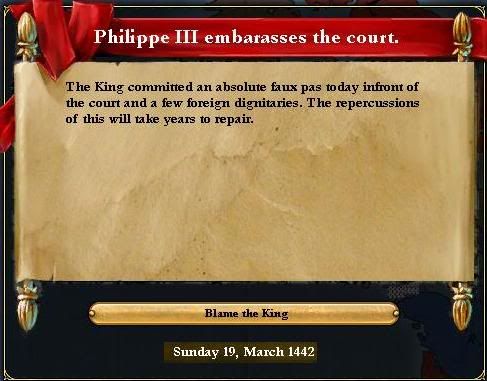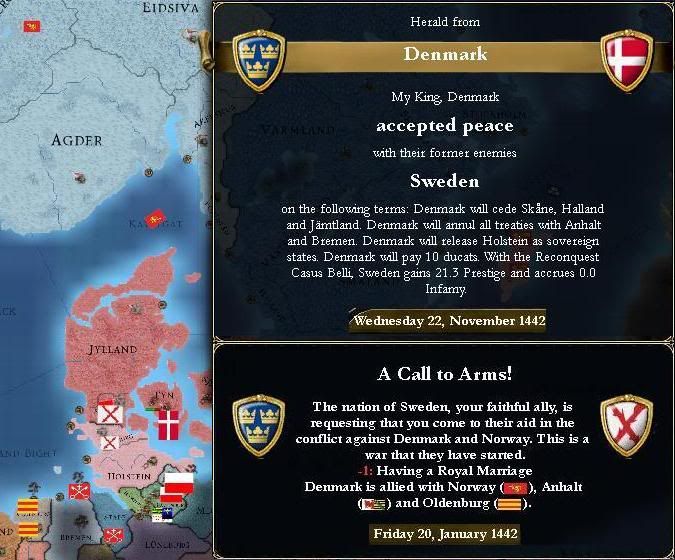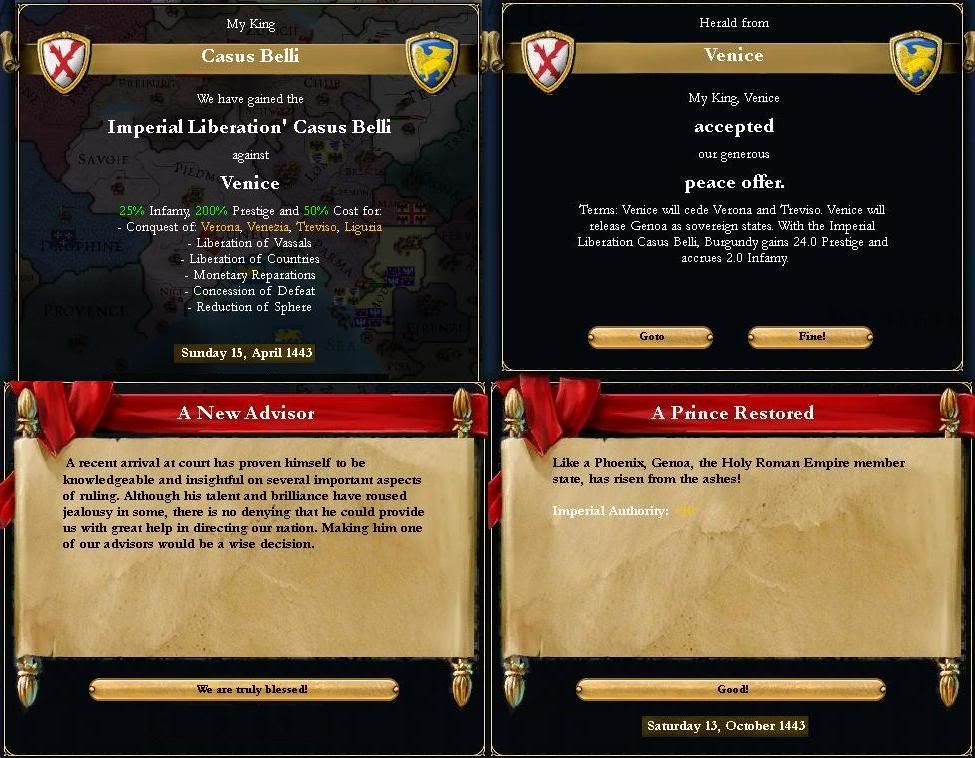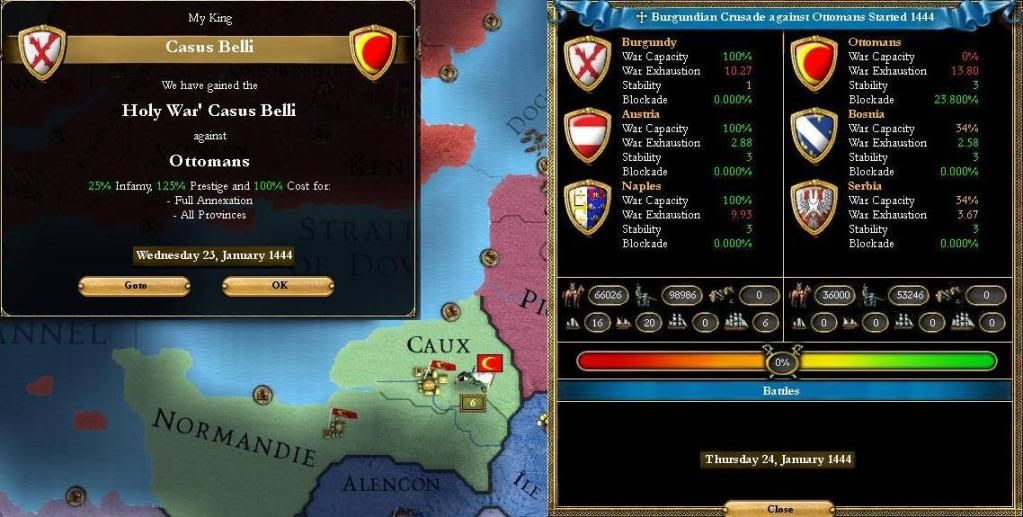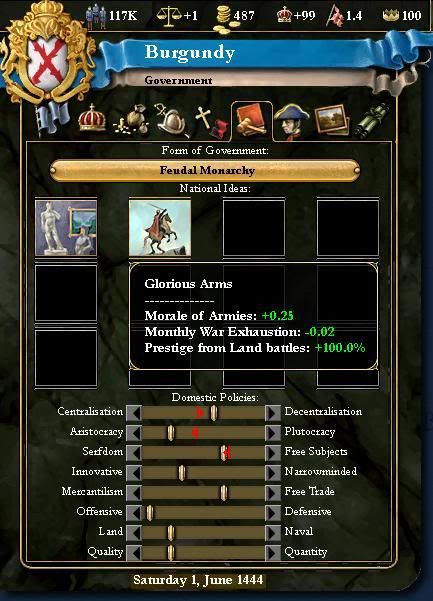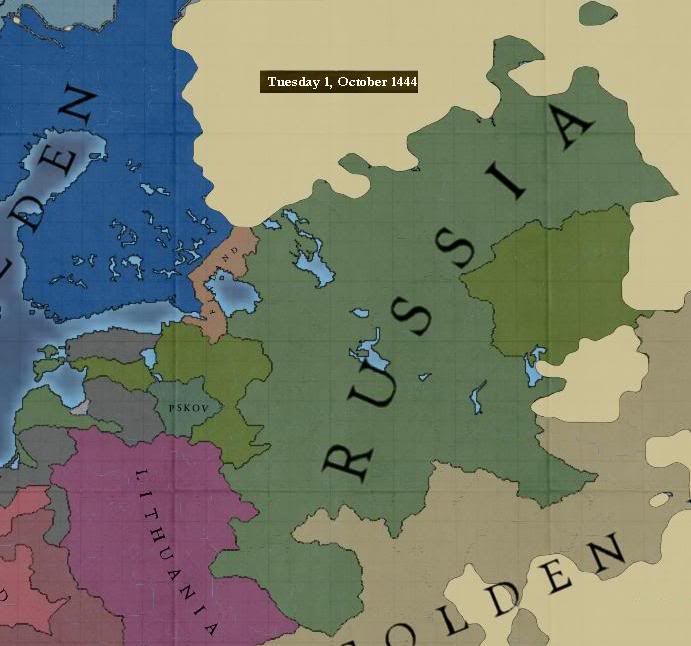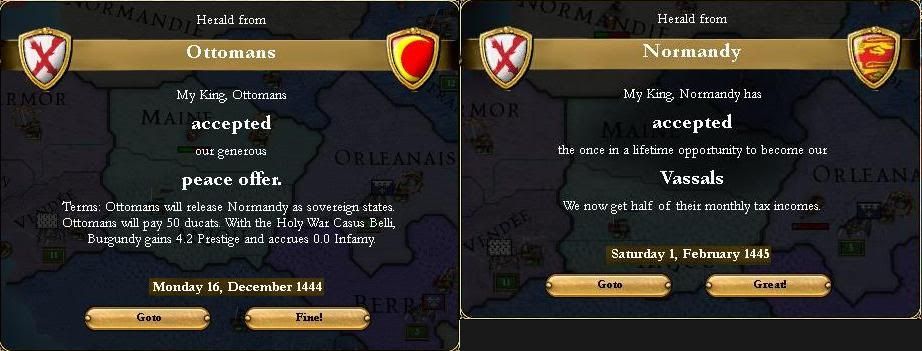Chapter IV - Once Upon a Time in the Netherlands
Philippe III, Duke of Burgundy
Burgundy in 1417 at the accession of Philippe III
Aged just 14 and three-quarters, Philippe de Valois-Bourgogne formally married his second cousin Michelle de Valois at noon on Saturday, 12th April 1417, in Dijon Cathedral, and they were crowned on the Monday after as Duke-regnant and Duchess-consort of Burgundy, Brabant & Lothier, Limburg, etc. The following weekend, Philippe issued his first writ by confirming his younger uncle, Count Philippe, as his heir presumptive, until such time as he and the Duchess could provide heirs of their own.
Unfortunately, whilst Michelle became pregnant in winter, for all to see by spring, not even a year after being confirmed as heir, Philippe, Count of Nevers, fell ill and died of a nasty spring fever in April 1418. Three months later, Michelle gave birth to a healthy young boy, whom they named Philippe in the late Count's honour.
Whilst Duke Philppe was agreeing a white peace with the English, concluding the last piece of unfinished business from the regency period, his sole remaining uncle, Antoine, Count of Rethel, married Elisabeth, Duchess of Luxembourg, on the understanding that Philippe would be named as her heir if she and Antoine remained childless.
After attending Christmas Mass at Liegè and receiving Bishop Jean VI's pledge of fealty anew, Philippe and Michelle returned to Dijon, where the Duke drew up documents formally incorporating the former bishopric into Lower Burgundy. News from Luxembourg was not so pleasant, as the Duchess had just recovered from a brief but near-fatal illness and it became well-known that she deeply regretted her marriage pledge, especially as the gossips whispered that the Devil had stripped away her fertility in return for her life.
Mindful of his father's conquests and his grandfather's political skill, he spent all of Spring 1419 building up Burgundy's military and defensive capabilities and planning how best to ensure Burgundian domination throughout the Netherlands, before declaring war on Luxembourg, citing a breach of marriage vows on her part. This was a clearly transparent excuse to secure the Luxembourgian legacy and avoid the gossips being proved wrong, and King Karoly of Hungary, the Duke of Modena and others declared war on Burgundy in response. Luxembourg Castle fell within the year and Elisabeth was forced to swear fealty to Philippe, confirm his right to her duchy and agree to administer her lands as he willed.
That same year, for their parts (amongst others) in the Luxembourgian war, Frederik III, Prince-Bishop of Utrecht, ceded his secular authority and his sovereignty to Philippe and the Swiss Confederacy repudiated their territorial claims on Upper Burgundy. Although the rest of Europe looked upon Burgundy with much greater suspicion than before due to the complications resulting from the war, it had been more or less a complete success.
That winter, his nobles clamoured for Holland to incorporated into Greater Burgundy as well, but if the Luxembourg experience had taught him anything, it was that no matter how righteous your cause or how slight the obstacle, sometimes patience was just as important as direct action. Besides, his aunt Margaret, Countess of Holland and Zeeland, was still in good health and Jacqueline, her daughter by William of Bavaria, was of eminently marriageable age.
The next two years passed without major incident, but Michelle had become increasingly withdrawn after the birth of her son and was now dangerously melancholic. Whilst convalescing in the castle at Bois-le-duc, in the province of Breda, news came that she had died suddenly in her sleep. The death of the Duchess-consort would have been bad enough by itself, as she was well-liked by the people and helped maintain vital relations with France, but it came at a time of relatively high taxation and further changes to the mediaeval privileges and codes of customs still prevalent in Flanders.
8,000 men arose under the command of Pascal de Lugny, the castellan at Bois-le-duc, who claimed that the Duchess had named him the true heir of Burgundy before her passing, but the rebellion was short-lived and de Lugny met an ignominous end, his head piked on the city walls and his body crushed beneath the wheels of a loaded cart and then tossed into a gibbet for crows to feast upon.
Another three years passed, mostly without incident, though in the third year, Pope Martin V declared that one of the Duke's most pious and religious ancestors, Agnes of Arles, was to be made a new saint. There was much rejoicing in Burgundy and three new churches were commissioned in her honour.
It was in April 1425 that Sir Philippe de Vellexon, Lord-Ambassador of Burgundy, died in his sleep. He had served all three Dukes of Burgundy, ever since joining Philip the Bold's service as a young man, and had performed incalculable service to the realm. In gratitude, Philippe gave the old man a state funeral and provided his grieving widow with a very generous pension for the rest of her days.
The scale of Philippe de Vellexon's legacy was all too obvious when a map of Burgundy's diplomatic and dynastic ties was prepared in the months after his passing.
The time-honoured legal principle of "a year and a day" was evoked coincidentally by the independent Kingdom of Sweden asking for Burgundy's partnership in a military alliance, Always eager to find new allies against France and England, Philippe accepts the Swedish ambassador's request.
The Duchy of Mantua, the Kingdom of Hungary and the Joint-Kingdom of Denmark and Norway enjoy rulers from the Bourgogne dynasty.
In May 1427, Castille went to war with England once more and Burgundy once again came to their ally's assistance, even though this meant that Burgundy and Brittany, former comrades-in-arms, were now drawn on separate sides. At home, Philippe's Aunt Margaret, Countess of Holland, died and his cousin Jacqueline, now Countess of Holland and Zeeland herself, returned home from Brittany, bearing news that her husband, a Breton count, had taken the field with his duke against Castille and Burgundy.
Nine days later, the news came that Albrecht V, Archduke of Austria and Holy Roman Emperor, had died, leaving only an sickly infant heir (who soon died, ending the Habsburg dynasty in the male line) and whom the Imperial Electors deemed unfit to rule. In his place. Philippe III was declared
Romanorum imperator electus - King of the Germans and elected Holy Roman Emperor. Finally, he had a royal title, like his grandfather and great-grandfather before him. It had been a close-run thing, with the King of Bohemia also in contention for the title, but Burgundy was seen as a strong, stabilising influence in the west, with strong dynastic links and a proven military power against France and England.
The next summer, Countess Jacqueline received the sad news that she was now a widow and that her husband lay dead on the fields of Aquitaine. Philippe sent soldiers to garrison his cousin's castle in case of Breton reprisals against her, and saw the chance to make further gains for the Burgundian silk purse even out of the sow's ear that was the latest Castillian war.
Throughout the remainder of 1428, his finest diplomats curried favour with His Holiness in Rome, deploying all the influence that their master's role as Emperor now provided, and that Christmas, Pope Martin agreed that an internal match would be best for the young Dutch widow and whom better than her liege and cousin? Papers were drawn up, granting the necessary dispensation for consanguinity between first cousins, and on the 3rd of February, 1429, Philippe and Jacqueline each married for the second time, with Holland passing under direct Burgundian rule.
There is an old proverb that says that there is no rest for the wicked, and this holds true for the great and the good, whether they are good, wicked or somewhere in between. Just four weeks later, Charles VII, King of France, declared war on Provence in an attempt to regain the provinces of Maine and Anjou for the House of Valois and Philippe, his second cousin, was compelled to do his Imperial duty and declared war in support of Ladislao Durazzo, King of Naples and Count of Provence.
Philippe the Good
Anno Domini 1429
III Duke of Burgundy, II Duke of Brabant & Lothier, II Duke of Limburg
V Count Palatine of Burgundy, V Count of Artois, III Count of Flanders
II Count of Charolais, I Count of Hainaut
Jure uxoris: I Count of Holland and Zeeland
Jure bellum: I Duke of Luxembourg
Jure suffragium: Philip I, Holy Roman Emperor

